
Powering and transforming financial markets Investor PresentationMay 2025
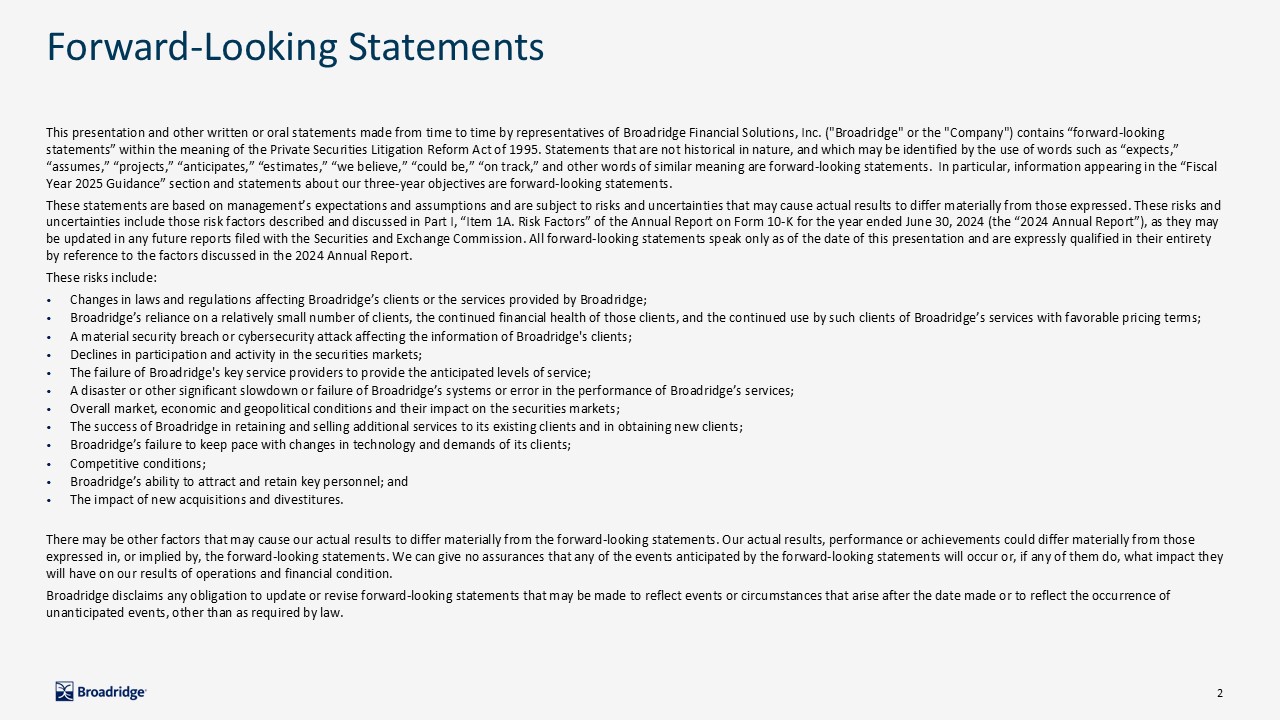
Forward-Looking Statements This presentation and other written or oral statements
made from time to time by representatives of Broadridge Financial Solutions, Inc. ("Broadridge" or the "Company") contains “forward-looking statements” within the meaning of the Private Securities Litigation Reform Act of 1995. Statements that
are not historical in nature, and which may be identified by the use of words such as “expects,” “assumes,” “projects,” “anticipates,” “estimates,” “we believe,” “could be,” “on track,” and other words of similar meaning are forward-looking
statements. In particular, information appearing in the “Fiscal Year 2025 Guidance” section and statements about our three-year objectives are forward-looking statements. These statements are based on management’s expectations and assumptions
and are subject to risks and uncertainties that may cause actual results to differ materially from those expressed. These risks and uncertainties include those risk factors described and discussed in Part I, “Item 1A. Risk Factors” of the
Annual Report on Form 10-K for the year ended June 30, 2024 (the “2024 Annual Report”), as they may be updated in any future reports filed with the Securities and Exchange Commission. All forward-looking statements speak only as of the date of
this presentation and are expressly qualified in their entirety by reference to the factors discussed in the 2024 Annual Report. These risks include: Changes in laws and regulations affecting Broadridge’s clients or the services provided by
Broadridge; Broadridge’s reliance on a relatively small number of clients, the continued financial health of those clients, and the continued use by such clients of Broadridge’s services with favorable pricing terms; A material security
breach or cybersecurity attack affecting the information of Broadridge's clients; Declines in participation and activity in the securities markets; The failure of Broadridge's key service providers to provide the anticipated levels of
service; A disaster or other significant slowdown or failure of Broadridge’s systems or error in the performance of Broadridge’s services; Overall market, economic and geopolitical conditions and their impact on the securities markets;
The success of Broadridge in retaining and selling additional services to its existing clients and in obtaining new clients; Broadridge’s failure to keep pace with changes in technology and demands of its clients; Competitive
conditions; Broadridge’s ability to attract and retain key personnel; and The impact of new acquisitions and divestitures. There may be other factors that may cause our actual results to differ materially from the forward-looking
statements. Our actual results, performance or achievements could differ materially from those expressed in, or implied by, the forward-looking statements. We can give no assurances that any of the events anticipated by the forward-looking
statements will occur or, if any of them do, what impact they will have on our results of operations and financial condition. Broadridge disclaims any obligation to update or revise forward-looking statements that may be made to reflect events
or circumstances that arise after the date made or to reflect the occurrence of unanticipated events, other than as required by law.
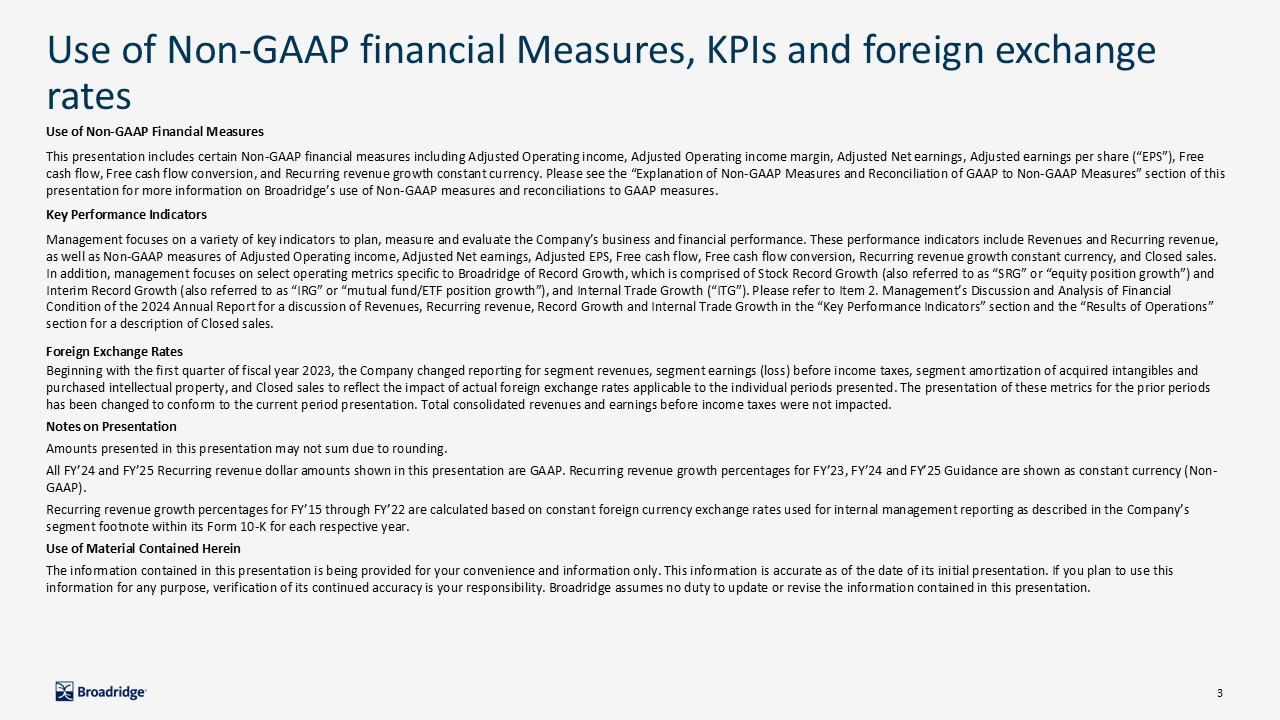
Use of Non-GAAP financial Measures, KPIs and foreign exchange rates Use of
Non-GAAP Financial Measures This presentation includes certain Non-GAAP financial measures including Adjusted Operating income, Adjusted Operating income margin, Adjusted Net earnings, Adjusted earnings per share (“EPS”), Free cash flow, Free
cash flow conversion, and Recurring revenue growth constant currency. Please see the “Explanation of Non-GAAP Measures and Reconciliation of GAAP to Non-GAAP Measures” section of this presentation for more information on Broadridge’s use of
Non-GAAP measures and reconciliations to GAAP measures. Key Performance Indicators Management focuses on a variety of key indicators to plan, measure and evaluate the Company’s business and financial performance. These performance indicators
include Revenues and Recurring revenue, as well as Non-GAAP measures of Adjusted Operating income, Adjusted Net earnings, Adjusted EPS, Free cash flow, Free cash flow conversion, Recurring revenue growth constant currency, and Closed sales. In
addition, management focuses on select operating metrics specific to Broadridge of Record Growth, which is comprised of Stock Record Growth (also referred to as “SRG” or “equity position growth”) and Interim Record Growth (also referred to as
“IRG” or “mutual fund/ETF position growth”), and Internal Trade Growth (“ITG”). Please refer to Item 2. Management’s Discussion and Analysis of Financial Condition of the 2024 Annual Report for a discussion of Revenues, Recurring revenue,
Record Growth and Internal Trade Growth in the “Key Performance Indicators” section and the “Results of Operations” section for a description of Closed sales. Foreign Exchange Rates Beginning with the first quarter of fiscal year 2023, the
Company changed reporting for segment revenues, segment earnings (loss) before income taxes, segment amortization of acquired intangibles and purchased intellectual property, and Closed sales to reflect the impact of actual foreign exchange
rates applicable to the individual periods presented. The presentation of these metrics for the prior periods has been changed to conform to the current period presentation. Total consolidated revenues and earnings before income taxes were not
impacted. Notes on Presentation Amounts presented in this presentation may not sum due to rounding. All FY’24 and FY’25 Recurring revenue dollar amounts shown in this presentation are GAAP. Recurring revenue growth percentages for FY’23,
FY’24 and FY’25 Guidance are shown as constant currency (Non-GAAP). Recurring revenue growth percentages for FY’15 through FY’22 are calculated based on constant foreign currency exchange rates used for internal management reporting as
described in the Company’s segment footnote within its Form 10-K for each respective year. Use of Material Contained Herein The information contained in this presentation is being provided for your convenience and information only. This
information is accurate as of the date of its initial presentation. If you plan to use this information for any purpose, verification of its continued accuracy is your responsibility. Broadridge assumes no duty to update or revise the
information contained in this presentation.
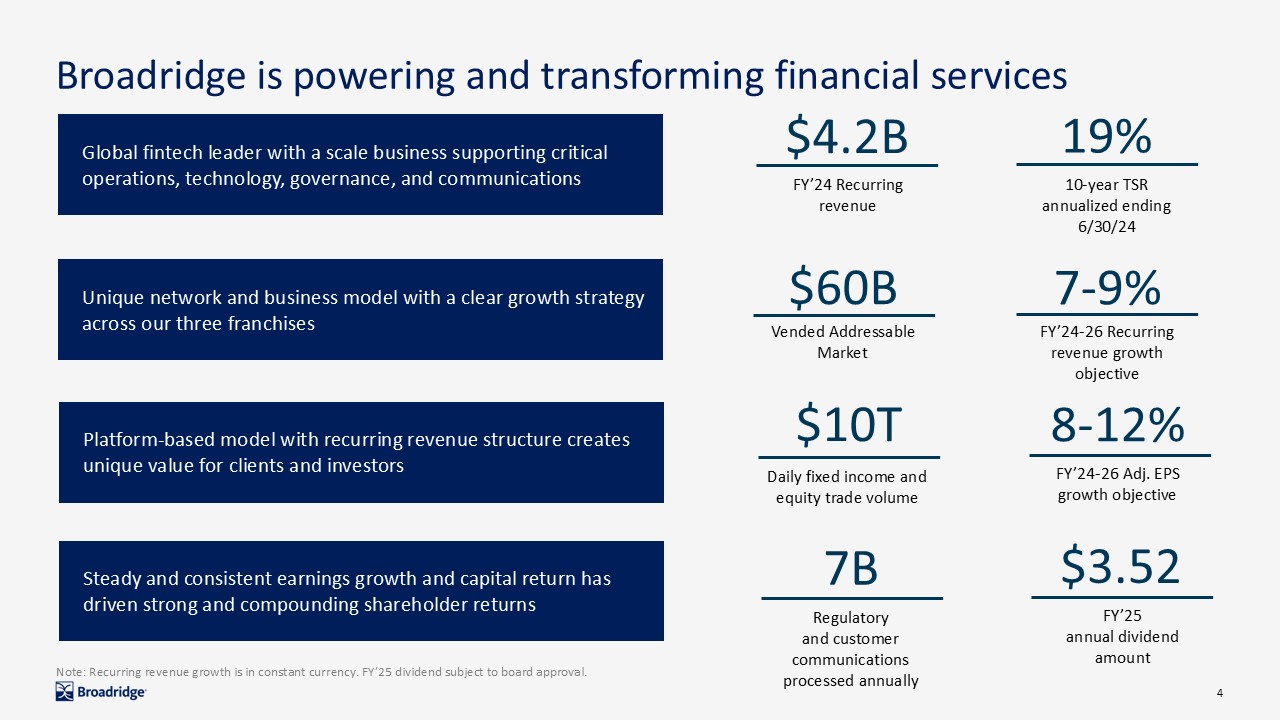
Broadridge is powering and transforming financial services Unique network and
business model with a clear growth strategy across our three franchises Platform-based model with recurring revenue structure creates unique value for clients and investors Steady and consistent earnings growth and capital return has driven
strong and compounding shareholder returns $4.2B FY’24 Recurring revenue 7-9% FY’24-26 Recurring revenue growth objective $60B Vended Addressable Market Global fintech leader with a scale business supporting critical operations,
technology, governance, and communications $10T Daily fixed income and equity trade volume 8-12% FY’24-26 Adj. EPS growth objective 19% 10-year TSR annualized ending 6/30/24 $3.52 FY’25annual dividend amount 7B Regulatory and
customer communications processed annually Note: Recurring revenue growth is in constant currency. FY’25 dividend subject to board approval.
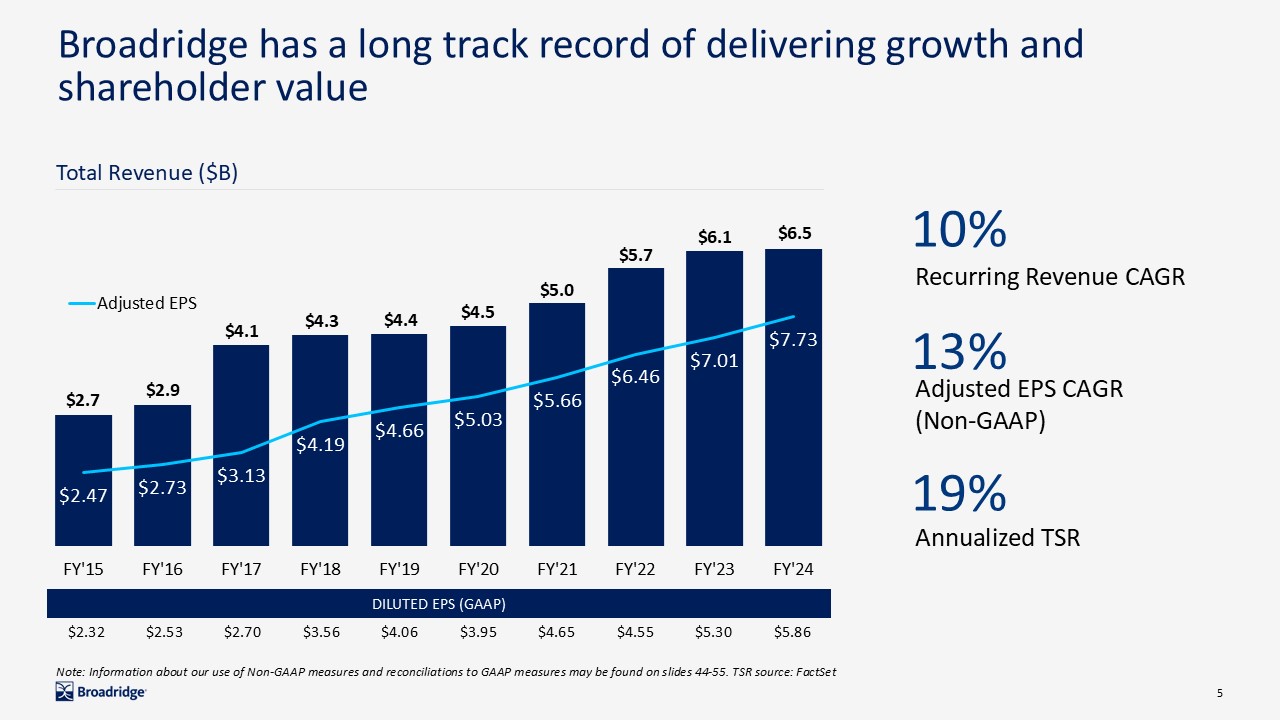
Broadridge has a long track record of delivering growth and shareholder
value Total Revenue ($B) 10% Recurring Revenue CAGR 13% Adjusted EPS CAGR (Non-GAAP) 19% Annualized TSR Note: Information about our use of Non-GAAP measures and reconciliations to GAAP measures may be found on slides 44-55. TSR source:
FactSet DILUTED EPS (GAAP) $2.32 $2.53 $2.70 $3.56 $4.06 $3.95 $4.65 $4.55 $5.30 $5.86
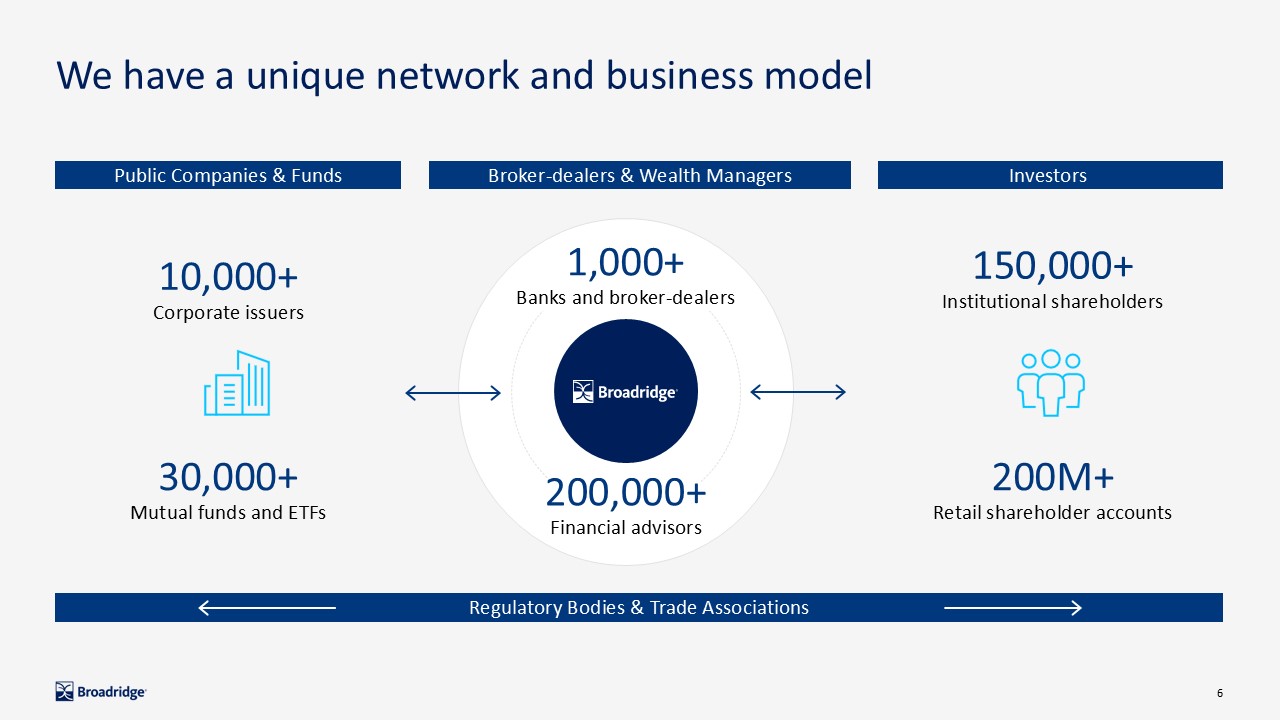
We have a unique network and business model Regulatory Bodies & Trade
Associations Broker-dealers & Wealth Managers Investors Public Companies & Funds 10,000+ Corporate issuers 1,000+ Banks and broker-dealers 30,000+ Mutual funds and ETFs 200,000+ Financial advisors 150,000+ Institutional
shareholders 200M+ Retail shareholder accounts
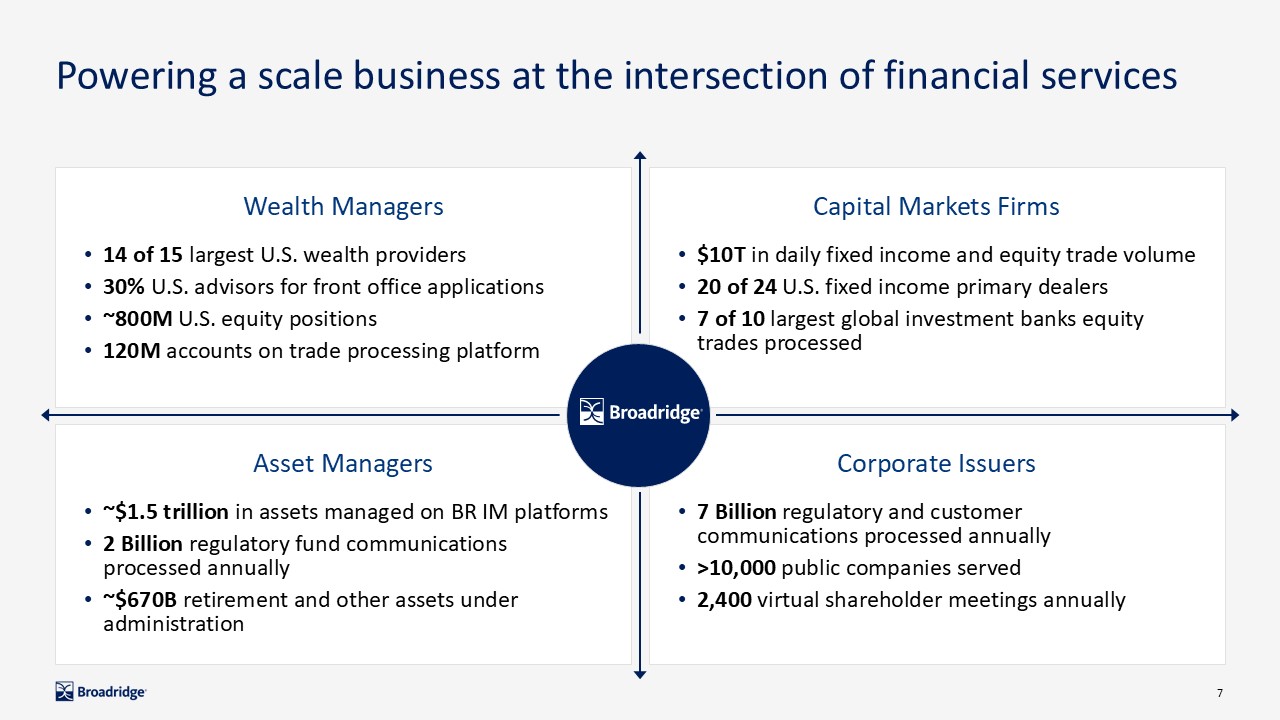
Powering a scale business at the intersection of financial services Wealth
Managers 30,000+ Mutual funds and ETFs 120,000+ Institutional shareholders 170M+ Retail shareholder accounts Capital Markets Firms Asset Managers Corporate Issuers 14 of 15 largest U.S. wealth providers 30% U.S. advisors for
front office applications ~800M U.S. equity positions 120M accounts on trade processing platform $10T in daily fixed income and equity trade volume 20 of 24 U.S. fixed income primary dealers 7 of 10 largest global investment banks equity
trades processed ~$1.5 trillion in assets managed on BR IM platforms 2 Billion regulatory fund communications processed annually ~$670B retirement and other assets under administration 7 Billion regulatory and customer communications
processed annually >10,000 public companies served 2,400 virtual shareholder meetings annually

We serve a $225B addressable market of which $60B+ is vended Source: McKinsey
& Co. $25B $24B Broadridge Vended Addressable Market 27% 73% Total Addressable Market $12B $225B $60B BR Vended
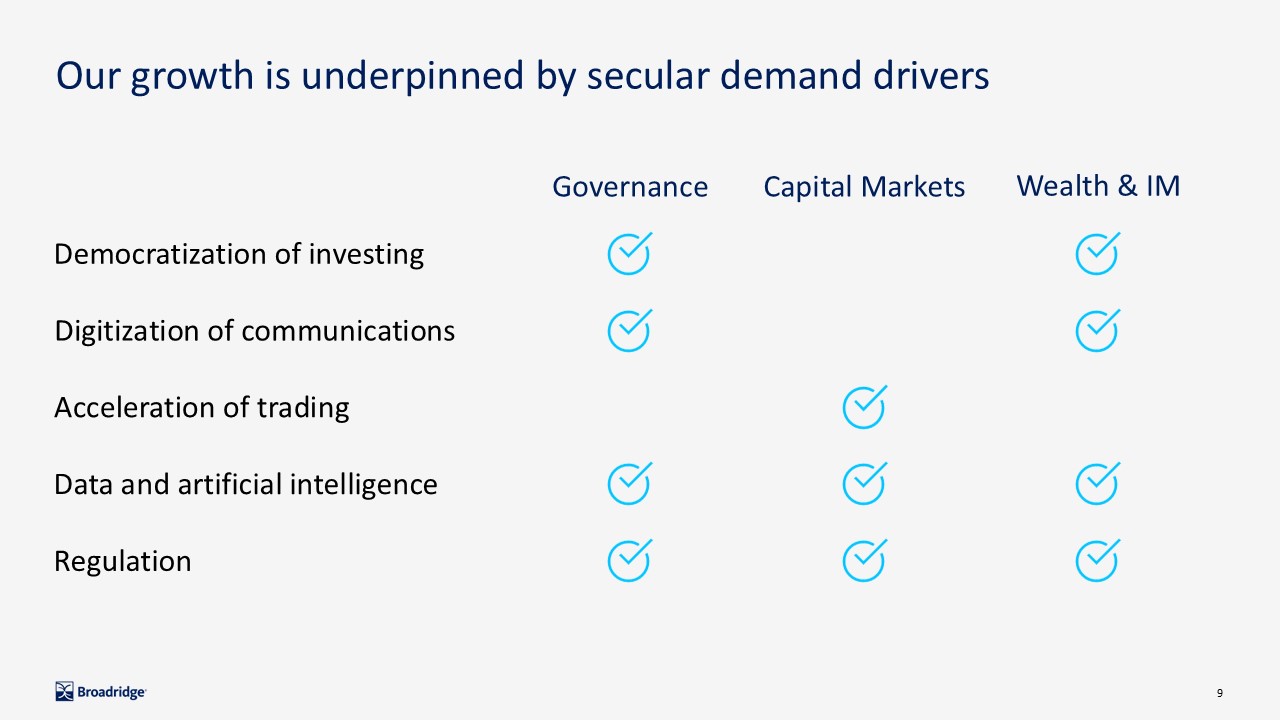
Our growth is underpinned by secular demand drivers Digitization of
communications Acceleration of trading Democratization of investing Data and artificial intelligence Regulation Governance Capital Markets Wealth & IM
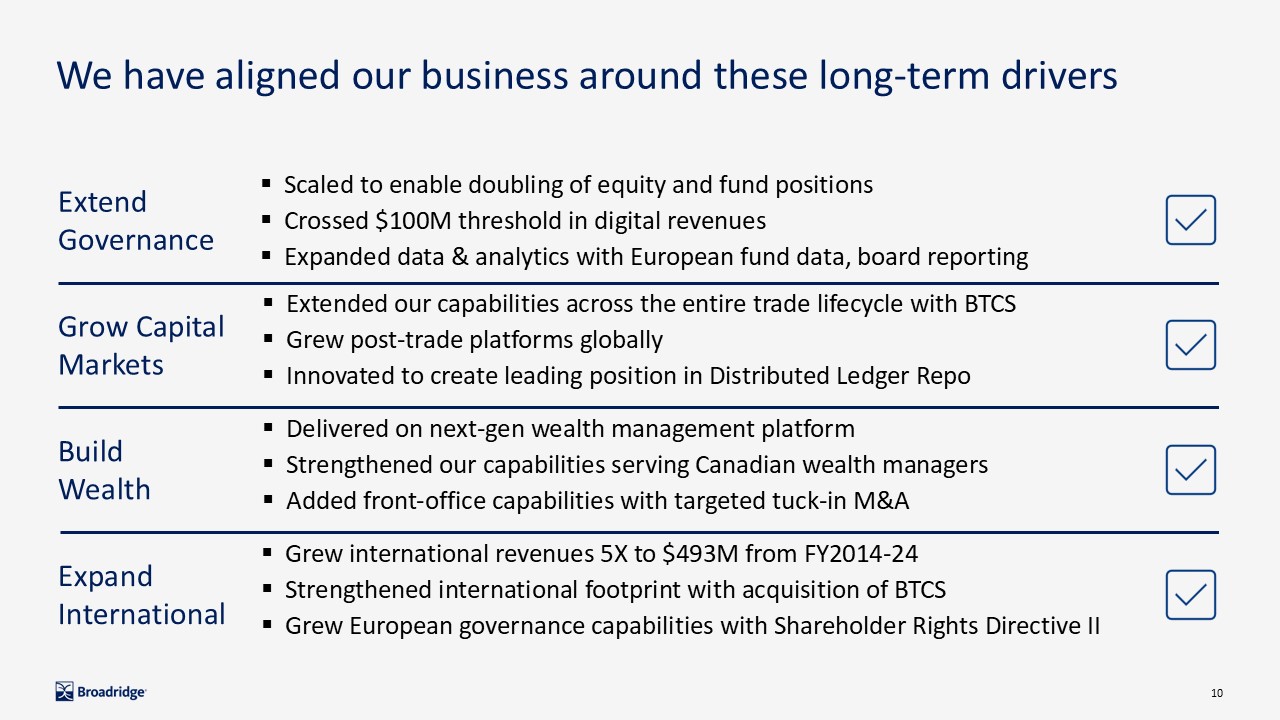
We have aligned our business around these long-term drivers Extend
Governance Scaled to enable doubling of equity and fund positions Crossed $100M threshold in digital revenues Expanded data & analytics with European fund data, board reporting Extended our capabilities across the entire trade
lifecycle with BTCS Grew post-trade platforms globally Innovated to create leading position in Distributed Ledger Repo Delivered on next-gen wealth management platform Strengthened our capabilities serving Canadian wealth managers Added
front-office capabilities with targeted tuck-in M&A Grew international revenues 5X to $493M from FY2014-24 Strengthened international footprint with acquisition of BTCS Grew European governance capabilities with Shareholder Rights
Directive II Grow Capital Markets Build Wealth Expand International

Driving Democratization and Digitization in Governance Drive democratization in
regulatory communications Digitize communications Leverage data for asset management Simplify corporate governance Simplifying Trading in Capital Markets Optimize trading and connectivity Simplify post-trade Deliver transformation and
innovation Modernizing Wealth Management Execute go-to market plan across multiple channels Enhance and integrate component solutions Deliver selective transformation opportunities We have a clear plan for long-term growth
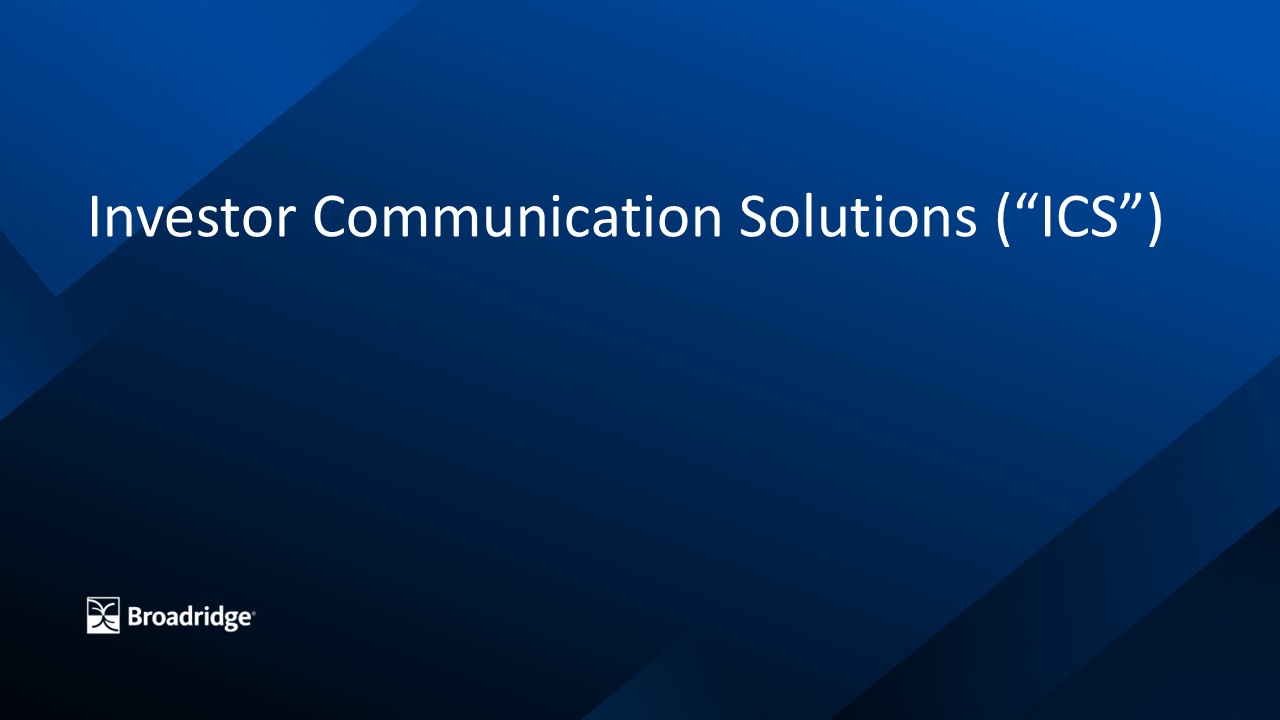
Investor Communication Solutions (“ICS”)

We continue to extend our strong and growing Governance franchise $2.6B ICS
Recurring Revenue Avg. annual growth 8% 10% Regulatory Data-Driven Fund Solutions Issuer Customer Communications 8% 14% 04% Note: Growth in constant currency. Information about our use of Non-GAAP measures and reconciliations to GAAP
measures may be found on slides 44 – 55 $1.2B $0.4B $0.3B $0.7B
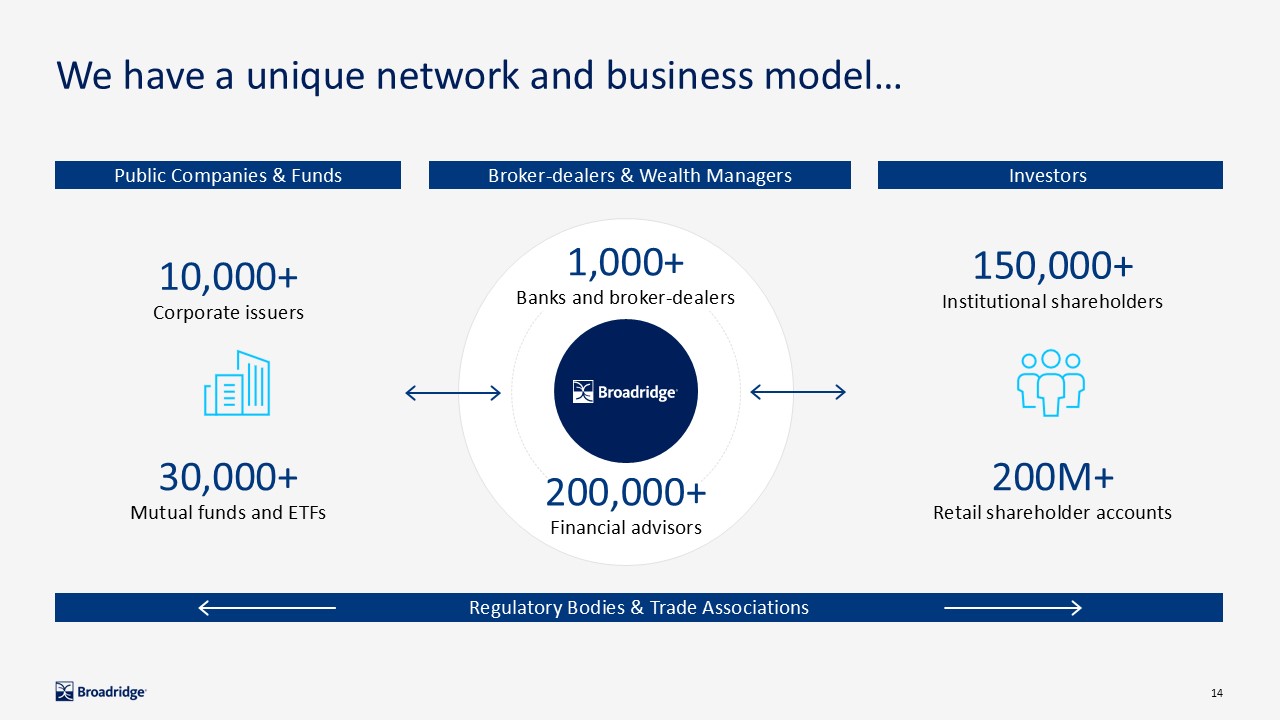
We have a unique network and business model… Regulatory Bodies & Trade
Associations Broker-dealers & Wealth Managers Investors Public Companies & Funds 10,000+ Corporate issuers 1,000+ Banks and broker-dealers 30,000+ Mutual funds and ETFs 200,000+ Financial advisors 150,000+ Institutional
shareholders 200M+ Retail shareholder accounts
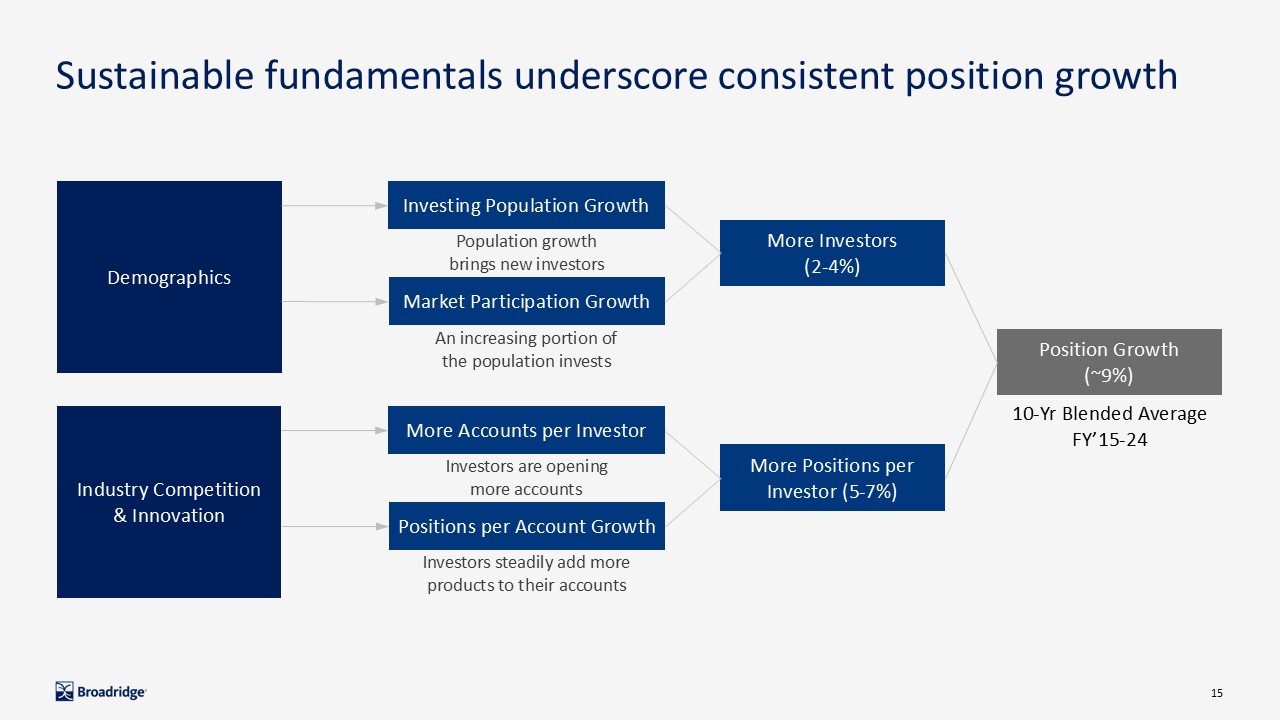
Sustainable fundamentals underscore consistent position growth Position
Growth (~9%) More Positions per Investor (5-7%) More Investors (2-4%) Investing Population Growth Market Participation Growth Population growth brings new investors An increasing portion of the population invests Demographics Industry
Competition & Innovation 10-Yr Blended Average FY’15-24 More Accounts per Investor Positions per Account Growth Investors are opening more accounts Investors steadily add more products to their accounts
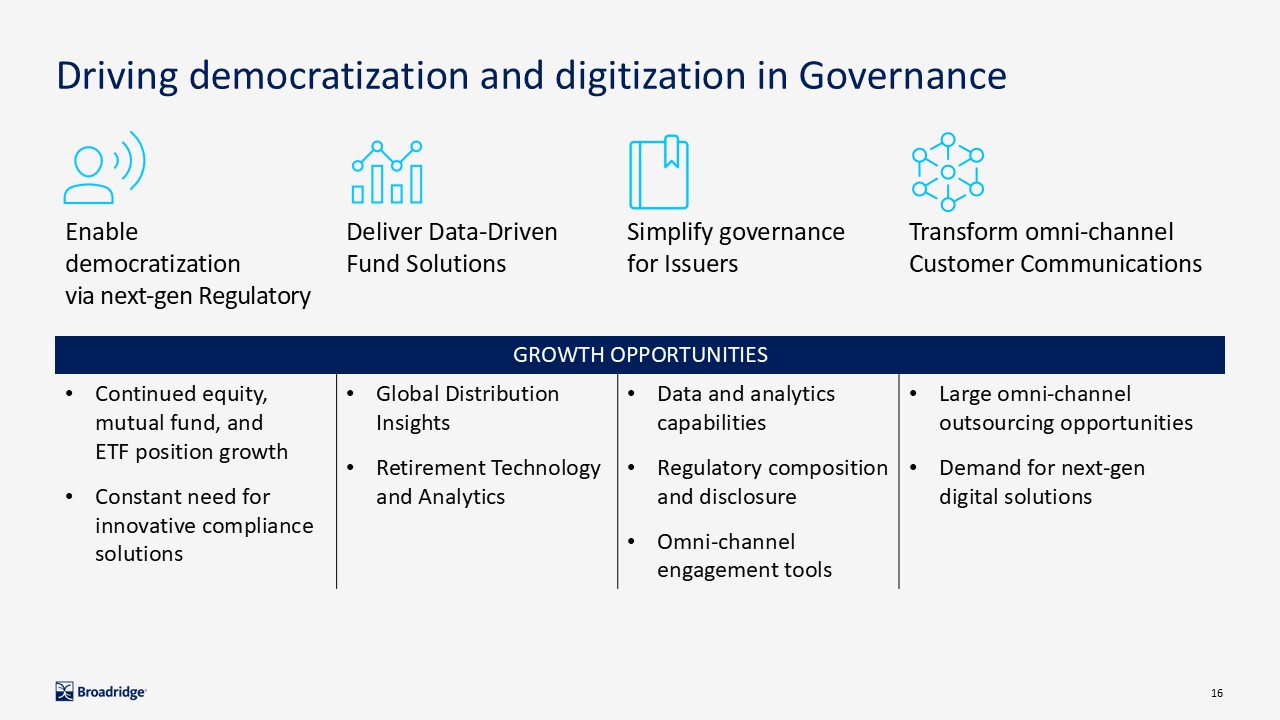
Enable democratization via next-gen Regulatory Deliver Data-Driven Fund
Solutions Simplify governance for Issuers Transform omni-channel Customer Communications Growth opportunities Continued equity, mutual fund, and ETF position growth Constant need for innovative compliance solutions Global Distribution
Insights Retirement Technology and Analytics Data and analytics capabilities Regulatory composition and disclosure Omni-channel engagement tools Large omni-channel outsourcing opportunities Demand for next-gen digital solutions Driving
democratization and digitization in Governance
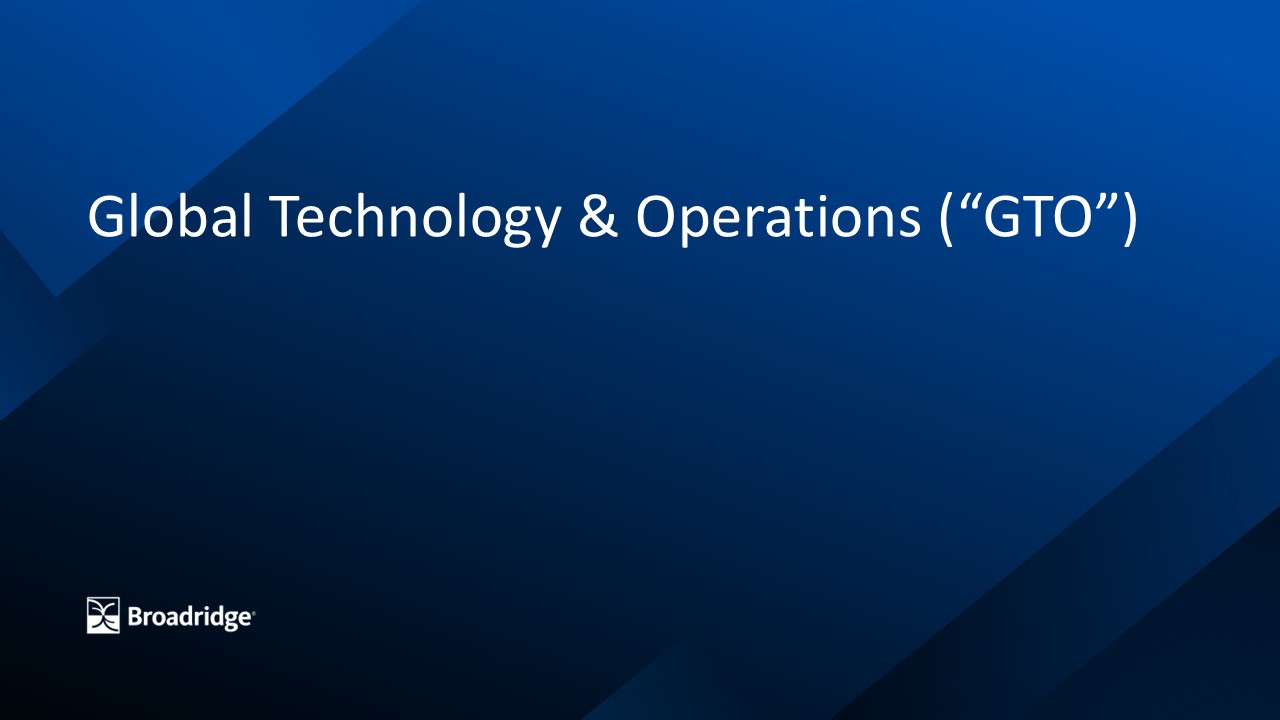
Global Technology & Operations (“GTO”)
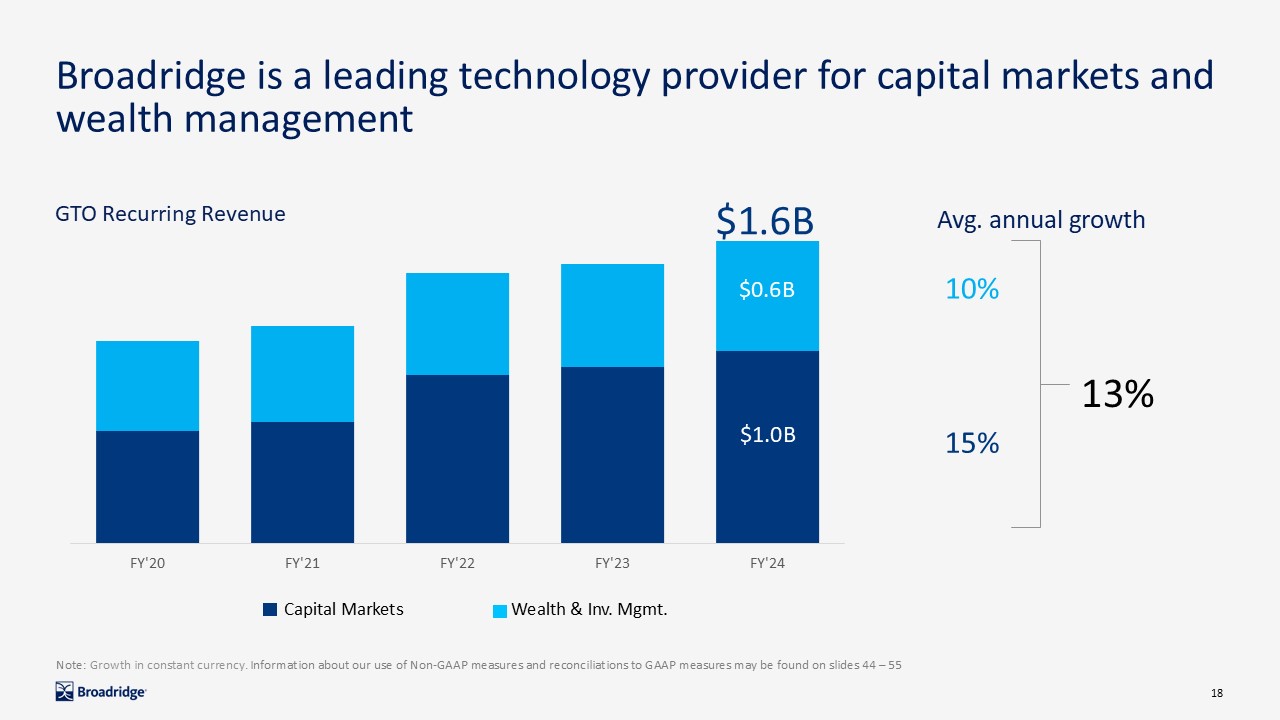
Broadridge is a leading technology provider for capital markets and wealth
management $1.6B GTO Recurring Revenue Avg. annual growth 13% 10% Capital Markets Wealth & Inv. Mgmt. 15% Note: Growth in constant currency. Information about our use of Non-GAAP measures and reconciliations to GAAP measures may be
found on slides 44 – 55 $0.6B $1.0B

Capital Markets: Broadridge technology powers the entire trade lifecycle Initiate
order Buy-side Sell-side Middle-office Lifecycle Events Trade Confirmation Allocation of Trade to Sub-accounts Trade Validation Middle-office Matching and Allocation Market Participants Back-office Lifecycle Events Trade Clearing
and Settlement Trade Booking Confirmations and Statements Sent Ongoing Asset Servicing Back-office Clearing, Settlement, Finance and Accounting Market Participants Front-office Trading and Execution Front-office Lifecycle
Events Order Capture and Trade Matching Order Routing to Exchange or OTC Party Trade Execution Notice of Execution Market Participants
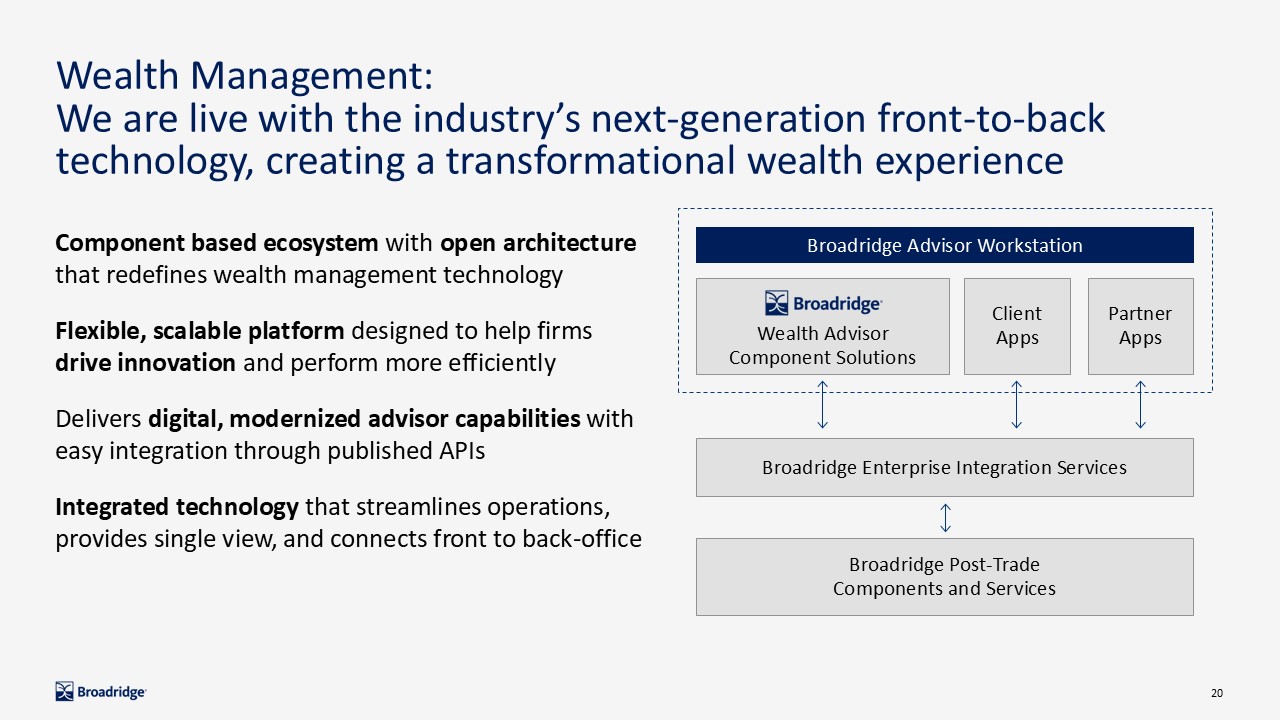
Component based ecosystem with open architecture that redefines wealth management
technology Flexible, scalable platform designed to help firms drive innovation and perform more efficiently Delivers digital, modernized advisor capabilities with easy integration through published APIs Integrated technology that
streamlines operations, provides single view, and connects front to back-office Broadridge Enterprise Integration Services Broadridge Post-Trade Components and Services Broadridge Advisor Workstation Wealth AdvisorComponent
Solutions Client Apps Partner Apps Wealth Management:We are live with the industry’s next-generation front-to-back technology, creating a transformational wealth experience
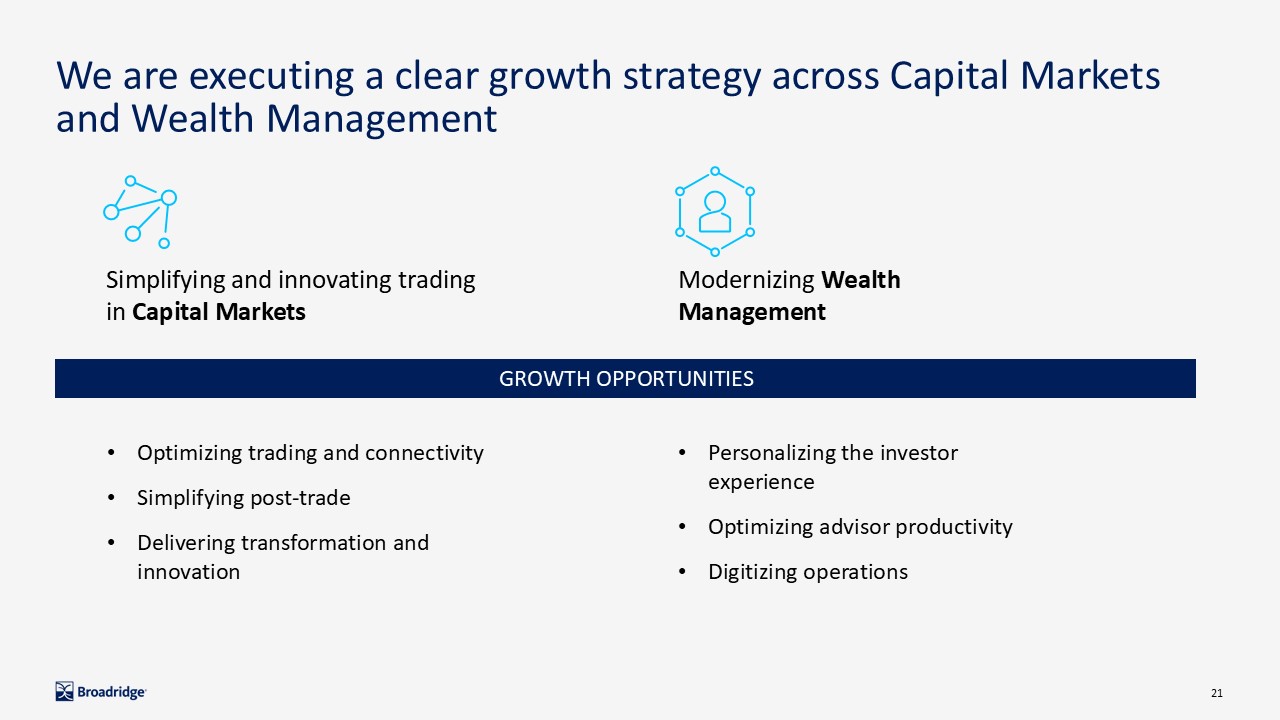
Growth opportunities We are executing a clear growth strategy across Capital
Markets and Wealth Management Personalizing the investor experience Optimizing advisor productivity Digitizing operations Optimizing trading and connectivity Simplifying post-trade Delivering transformation and innovation Modernizing
Wealth Management Simplifying and innovating trading in Capital Markets

A financial model powering sustainable long-term growth with high returns
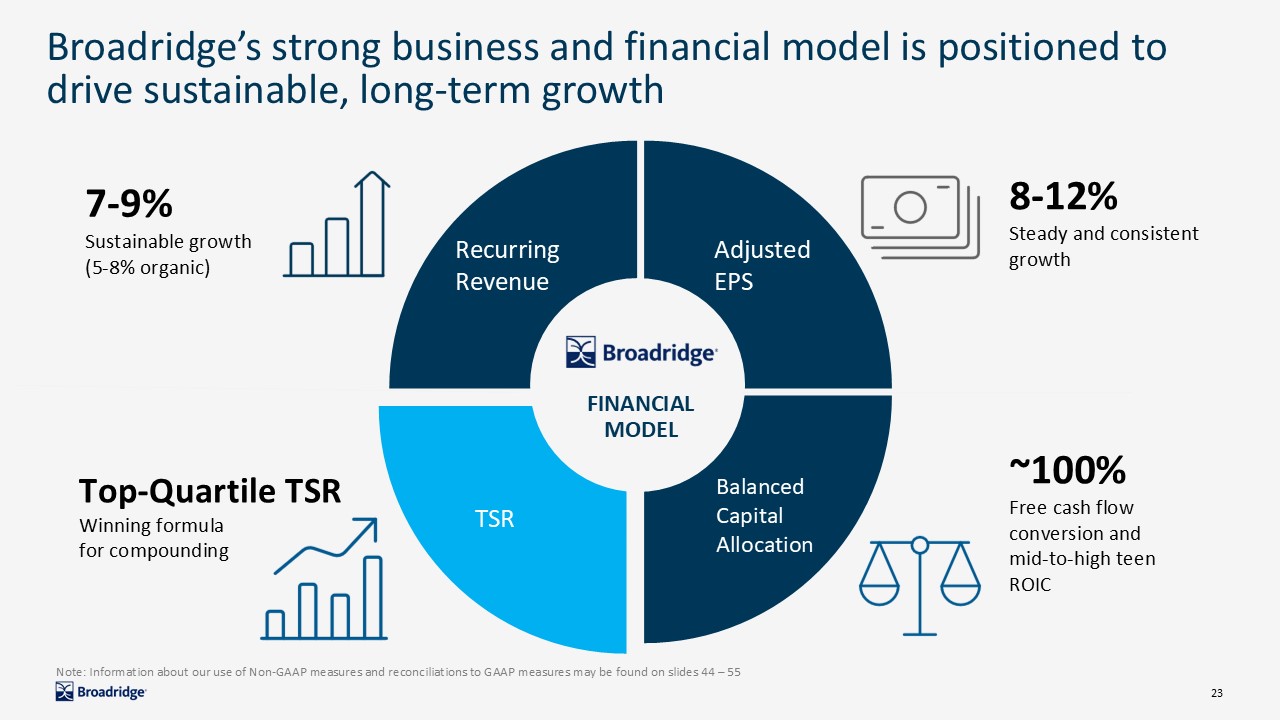
Broadridge’s strong business and financial model is positioned to drive
sustainable, long-term growth Recurring Revenue Balanced Capital Allocation TSR Adjusted EPS ~100% Free cash flow conversion and mid-to-high teen ROIC 7-9%Sustainable growth (5-8% organic) 8-12% Steady and consistent
growth Top-Quartile TSRWinning formula for compounding Financial Model Note: Information about our use of Non-GAAP measures and reconciliations to GAAP measures may be found on slides 44 – 55
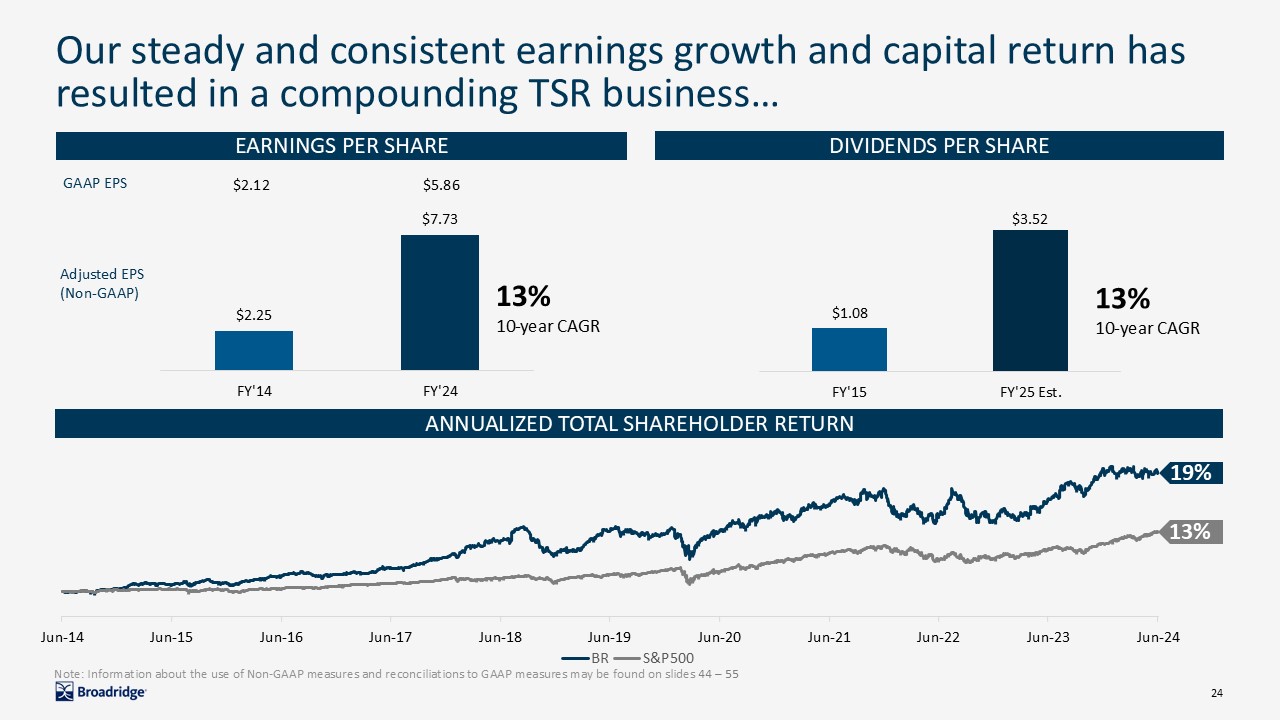
Note: Information about the use of Non-GAAP measures and reconciliations to GAAP
measures may be found on slides 44 – 55 Our steady and consistent earnings growth and capital return has resulted in a compounding TSR business… 13% 10-year CAGR EARNINGS PER SHARE DIVIDENDS PER SHARE ANNUALIZED TOTAL SHAREHOLDER
RETURN 13% 10-year CAGR 19% 13% GAAP EPS $2.12 $5.86 Adjusted EPS (Non-GAAP)
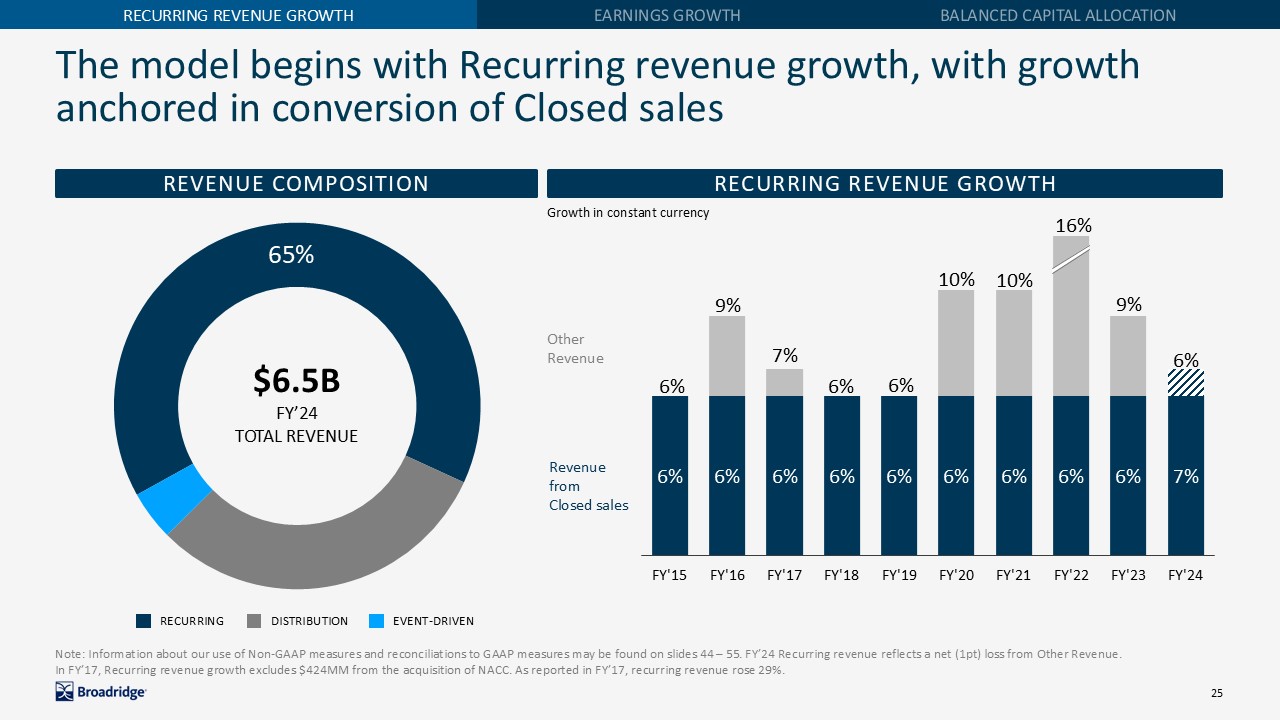
The model begins with Recurring revenue growth, with growth anchored in conversion
of Closed sales Recurring Revenue growth Earnings growth Balanced capital allocation Recurring Distribution Event-Driven $6.5BFY’24TOTAL REVENUE REVENUE COMPOSITION RECURRING REVENUE GROWTH Growth in constant currency Note:
Information about our use of Non-GAAP measures and reconciliations to GAAP measures may be found on slides 44 – 55. FY’24 Recurring revenue reflects a net (1pt) loss from Other Revenue. In FY’17, Recurring revenue growth excludes $424MM from
the acquisition of NACC. As reported in FY’17, recurring revenue rose 29%. 9% 16% 10% 10% 6% 6% 7% 9% 6% Revenue from Closed sales Other Revenue 6%
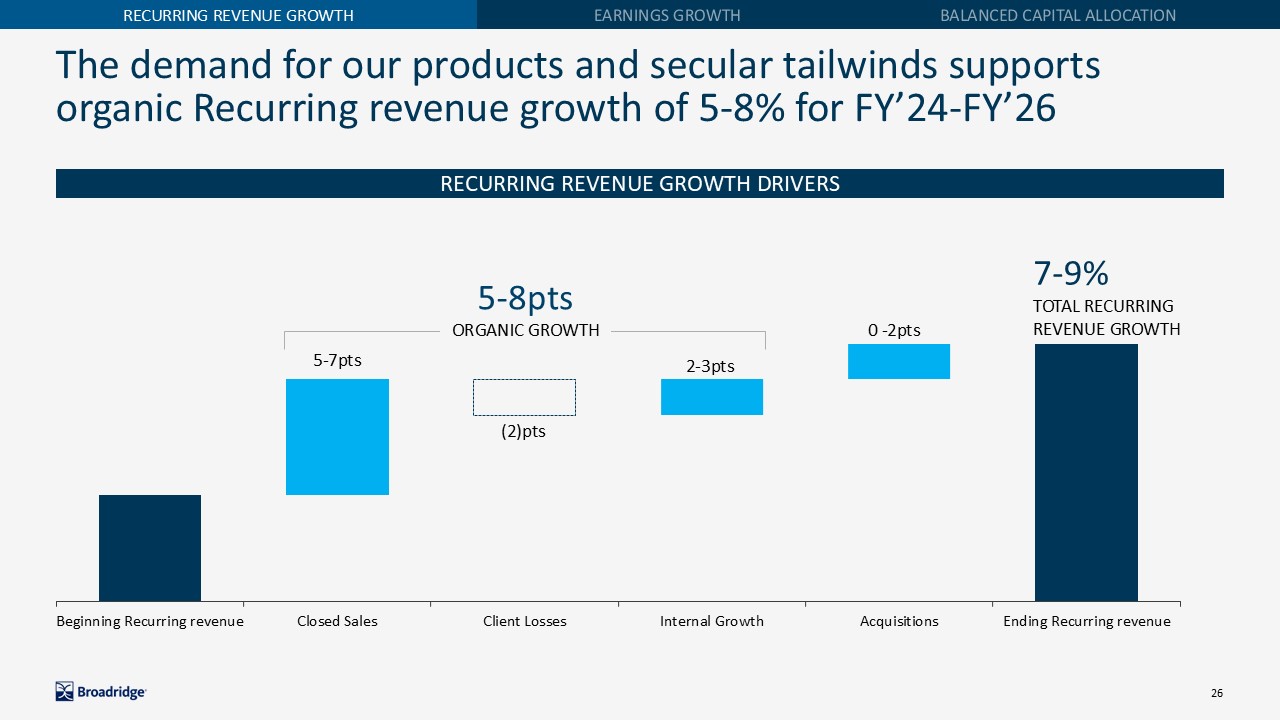
The demand for our products and secular tailwinds supports organic Recurring
revenue growth of 5-8% for FY’24-FY’26 Recurring Revenue growth Earnings growth Balanced capital allocation RECURRING REVENUE GROWTH DRIVERS 5-7pts (2)pts 2-3pts 0 -2pts 7-9%Total Recurring Revenue Growth 5-8pts ORGANIC GROWTH
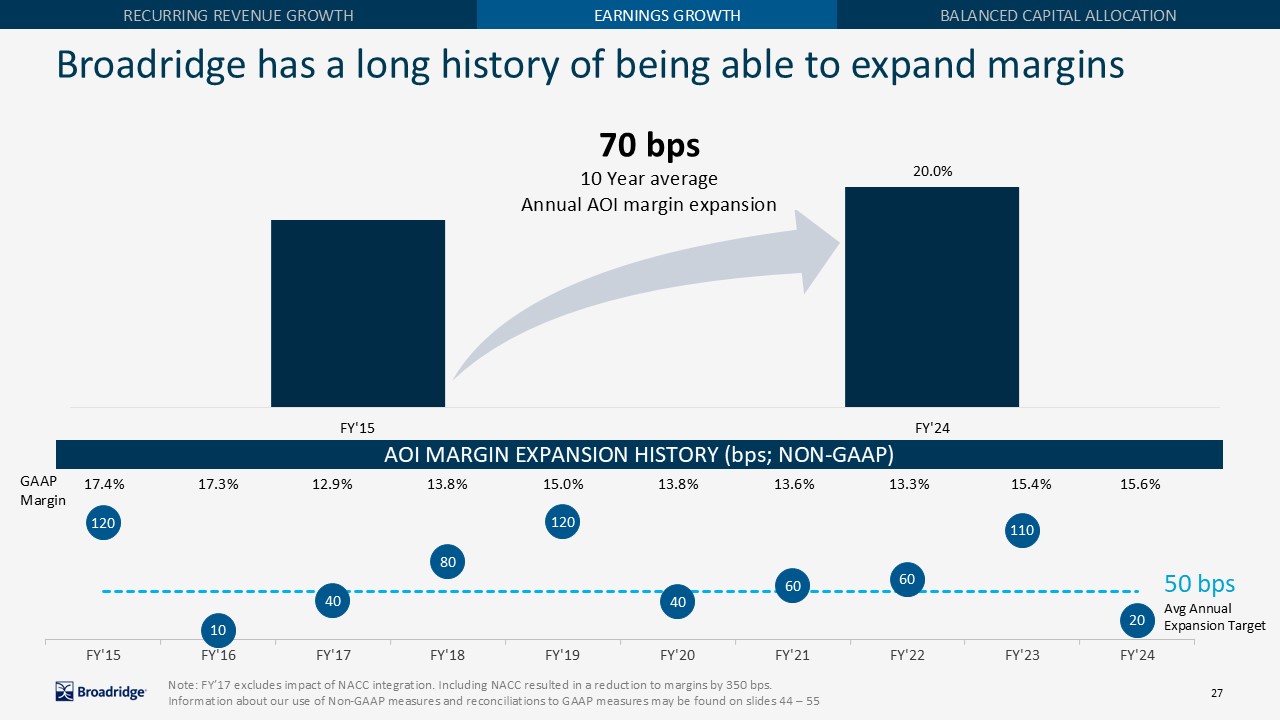
AOI MARGIN EXPANSION HISTORY (bps; NON-GAAP) 50 bps Avg Annual Expansion
Target 10 Year average Annual AOI margin expansion 70 bps Broadridge has a long history of being able to expand margins Recurring Revenue growth Earnings growth Balanced capital allocation Note: FY’17 excludes impact of NACC
integration. Including NACC resulted in a reduction to margins by 350 bps. Information about our use of Non-GAAP measures and reconciliations to GAAP measures may be found on slides 44 –
55 17.4% 17.3% 12.9% 13.8% 15.0% 13.8% 13.6% 13.3% 15.4% 15.6% GAAPMargin

Broadridge generates operating leverage through scale, higher-margin digital
growth and cost efficiency, allowing us to fund growth investments while delivering margin expansion Recurring Revenue growth Earnings growth Balanced capital allocation 50-70bps 20-30bps 10-20bps (40-60bps) 40-60bps
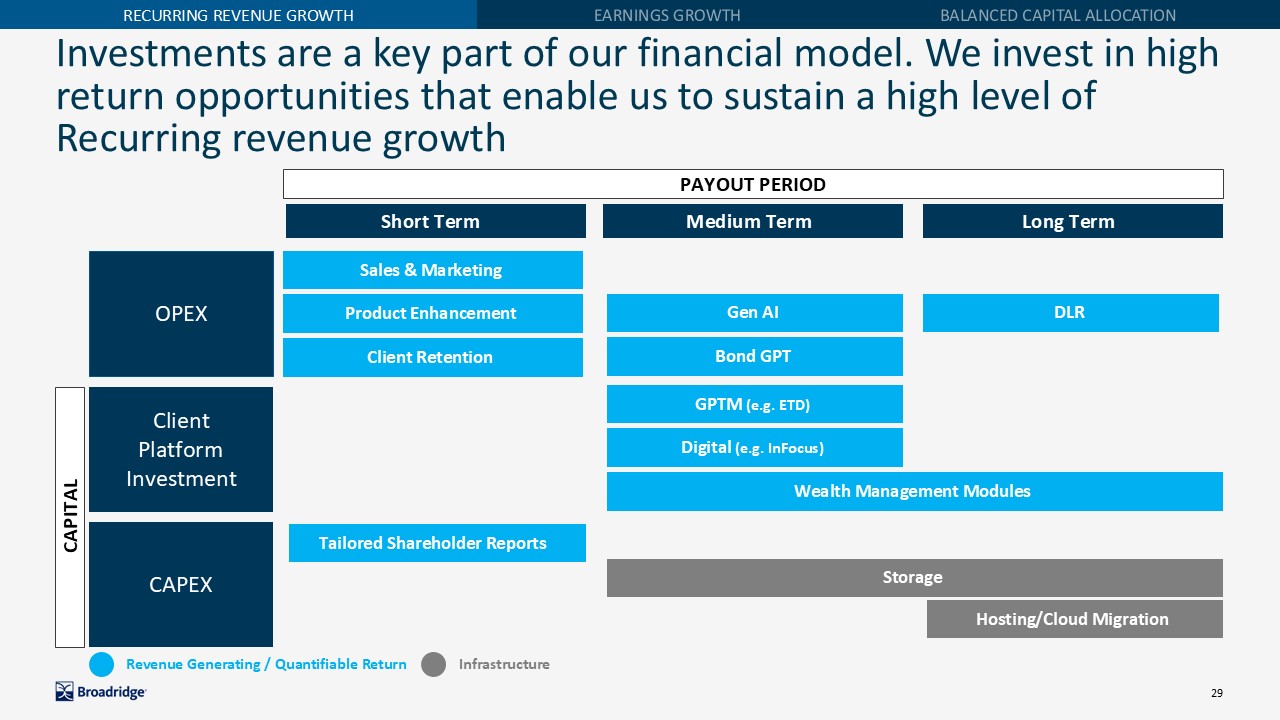
Investments are a key part of our financial model. We invest in high return
opportunities that enable us to sustain a high level of Recurring revenue growth Recurring Revenue growth Earnings growth Balanced capital allocation CAPEX Client Platform Investment OPEX Medium Term Long Term Product Enhancement
Digital (e.g. InFocus) DLR Sales & Marketing Gen AI Client Retention GPTM (e.g. ETD) Tailored Shareholder Reports Storage Hosting/Cloud Migration CAPITAL Short Term Wealth Management Modules Bond
GPT Infrastructure Revenue Generating / Quantifiable Return PAYOUT PERIOD
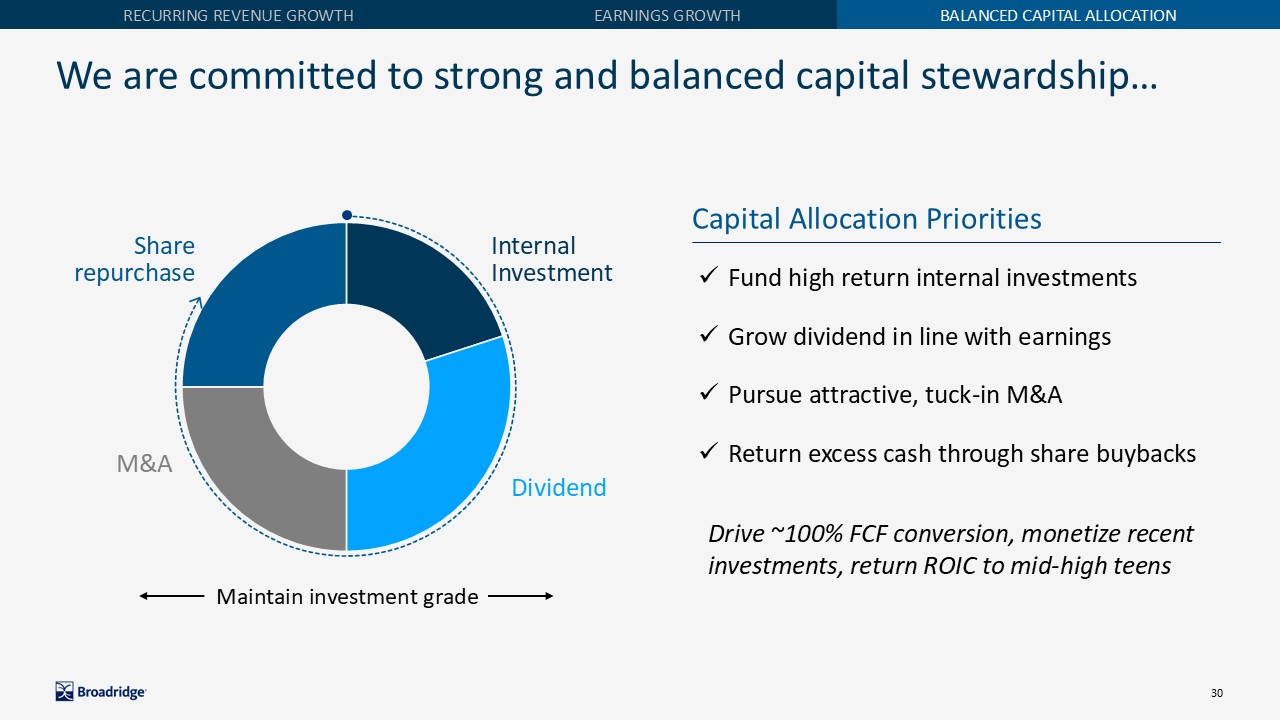
We are committed to strong and balanced capital
stewardship… M&A Internal Investment Dividend Share repurchase Maintain investment grade Drive ~100% FCF conversion, monetize recent investments, return ROIC to mid-high teens Capital Allocation Priorities Fund high return internal
investments Grow dividend in line with earnings Pursue attractive, tuck-in M&A Return excess cash through share buybacks Recurring Revenue growth Earnings growth Balanced capital allocation
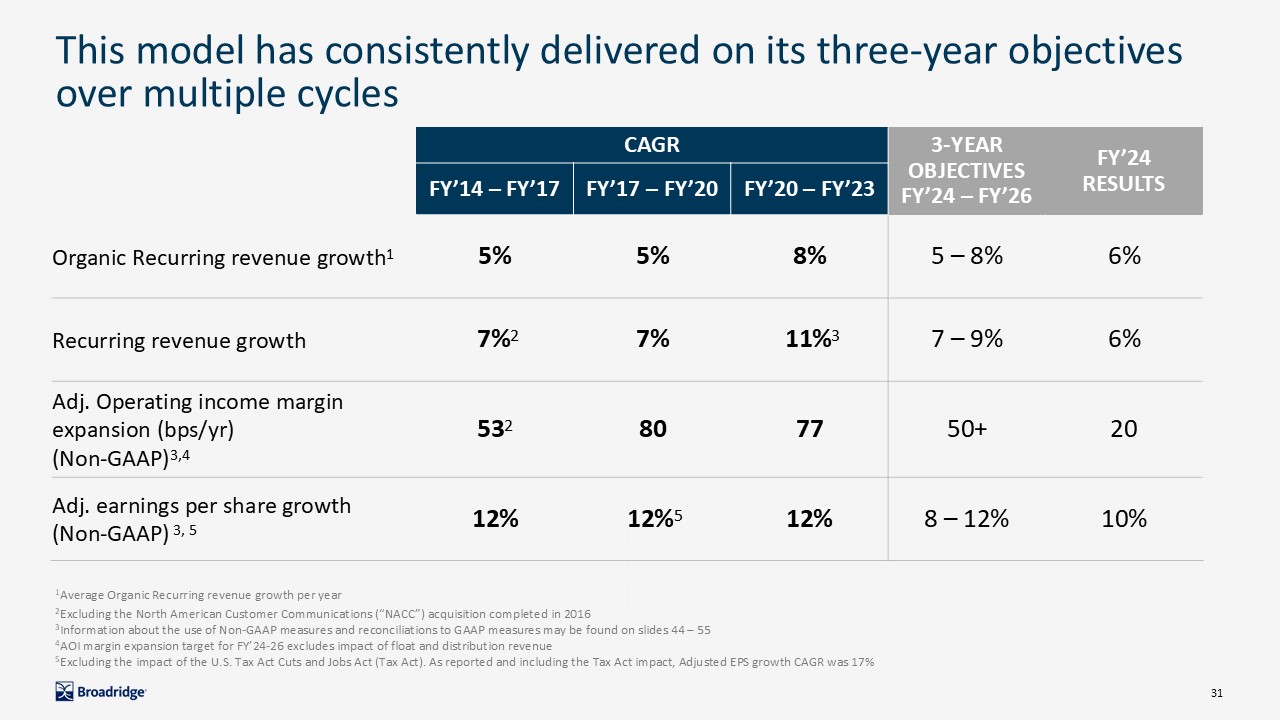
This model has consistently delivered on its three-year objectives over multiple
cycles cagr 3-year objectives FY’24 – Fy’26 FY’24 results FY’14 – FY’17 FY’17 – FY’20 FY’20 – FY’23 Organic Recurring revenue growth1 5% 5% 8% 5 – 8% 6% Recurring revenue growth 7%2 7% 11%3 7 – 9% 6% Adj. Operating income
margin expansion (bps/yr) (Non-GAAP)3,4 532 80 77 50+ 20 Adj. earnings per share growth (Non-GAAP) 3, 5 12% 12%5 12% 8 – 12% 10% 1Average Organic Recurring revenue growth per year 2Excluding the North American Customer
Communications (“NACC”) acquisition completed in 2016 3Information about the use of Non-GAAP measures and reconciliations to GAAP measures may be found on slides 44 – 55 4AOI margin expansion target for FY’24-26 excludes impact of float and
distribution revenue 5Excluding the impact of the U.S. Tax Act Cuts and Jobs Act (Tax Act). As reported and including the Tax Act impact, Adjusted EPS growth CAGR was 17%

Q3’25 results
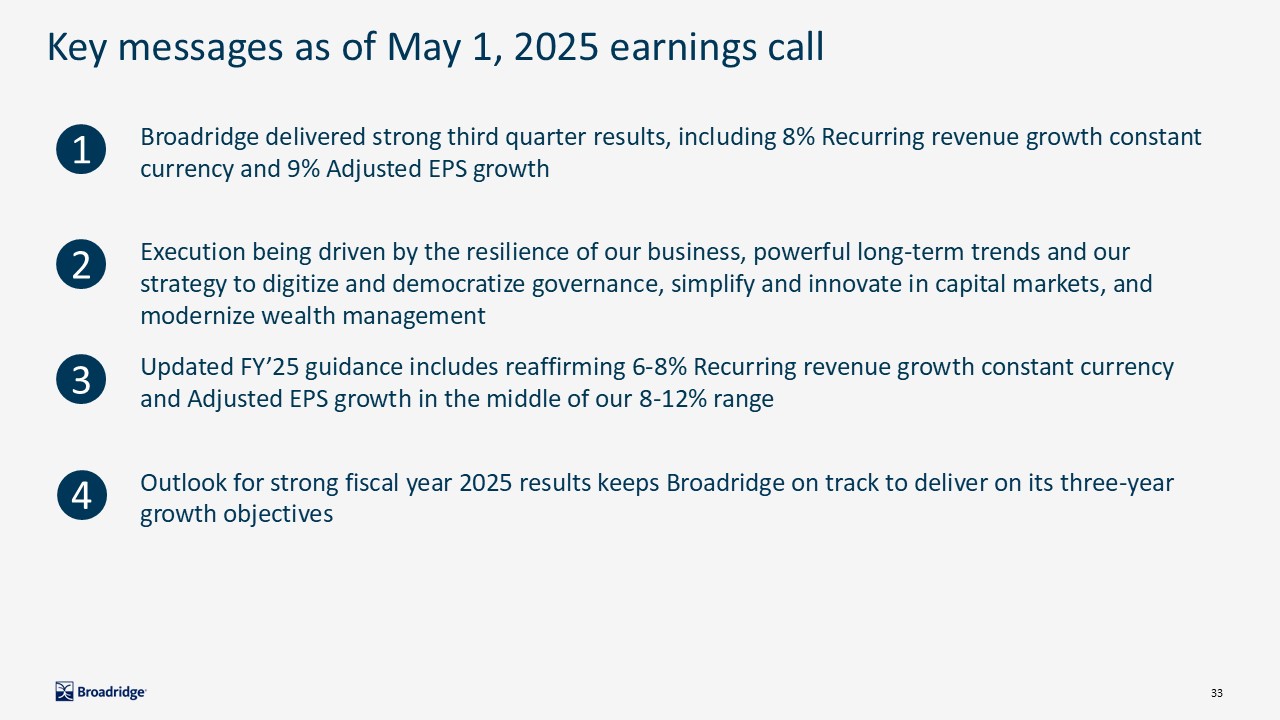
Key messages as of May 1, 2025 earnings call Broadridge delivered strong third
quarter results, including 8% Recurring revenue growth constant currency and 9% Adjusted EPS growth Execution being driven by the resilience of our business, powerful long-term trends and our strategy to digitize and democratize governance,
simplify and innovate in capital markets, and modernize wealth management Updated FY’25 guidance includes reaffirming 6-8% Recurring revenue growth constant currency and Adjusted EPS growth in the middle of our 8-12% range Outlook for strong
fiscal year 2025 results keeps Broadridge on track to deliver on its three-year growth objectives 1 2 3 4
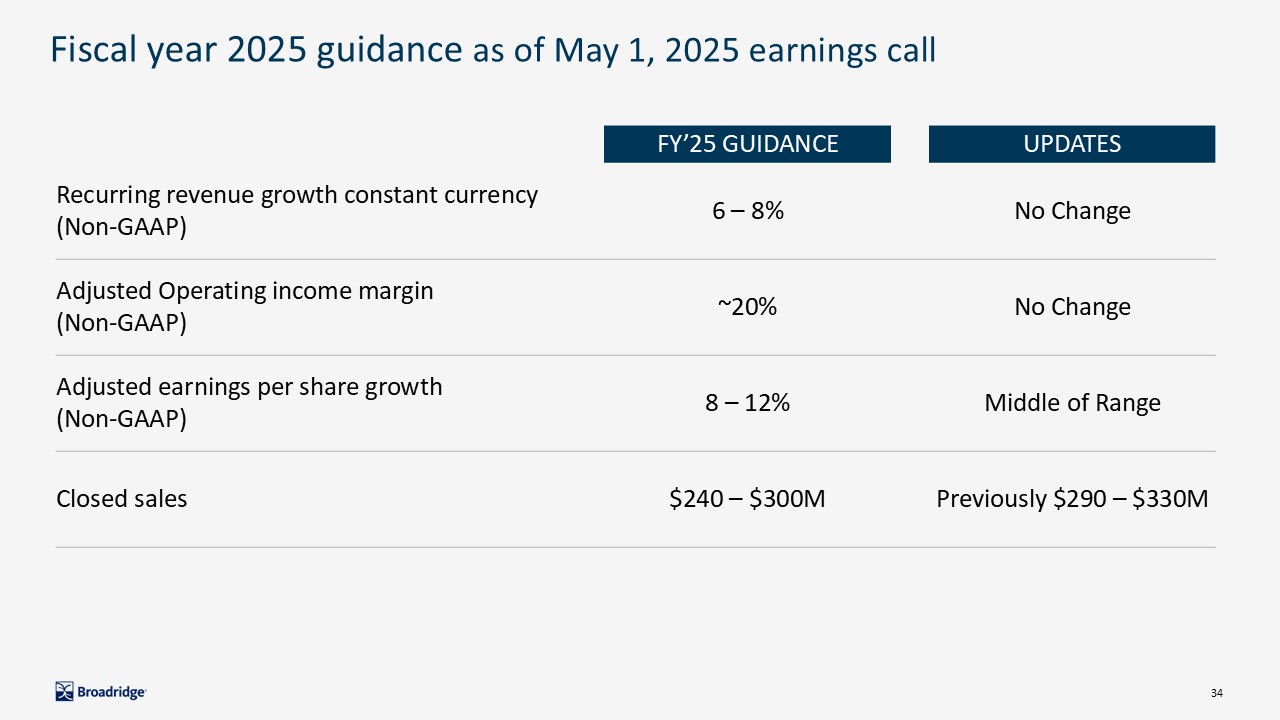
Fiscal year 2025 guidance as of May 1, 2025 earnings call Fy’25
guidance updates Recurring revenue growth constant currency (Non-GAAP) 6 – 8% No Change Adjusted Operating income margin (Non-GAAP) ~20% No Change Adjusted earnings per share growth (Non-GAAP) 8 – 12% Middle of Range Closed
sales $240 – $300M Previously $290 – $330M
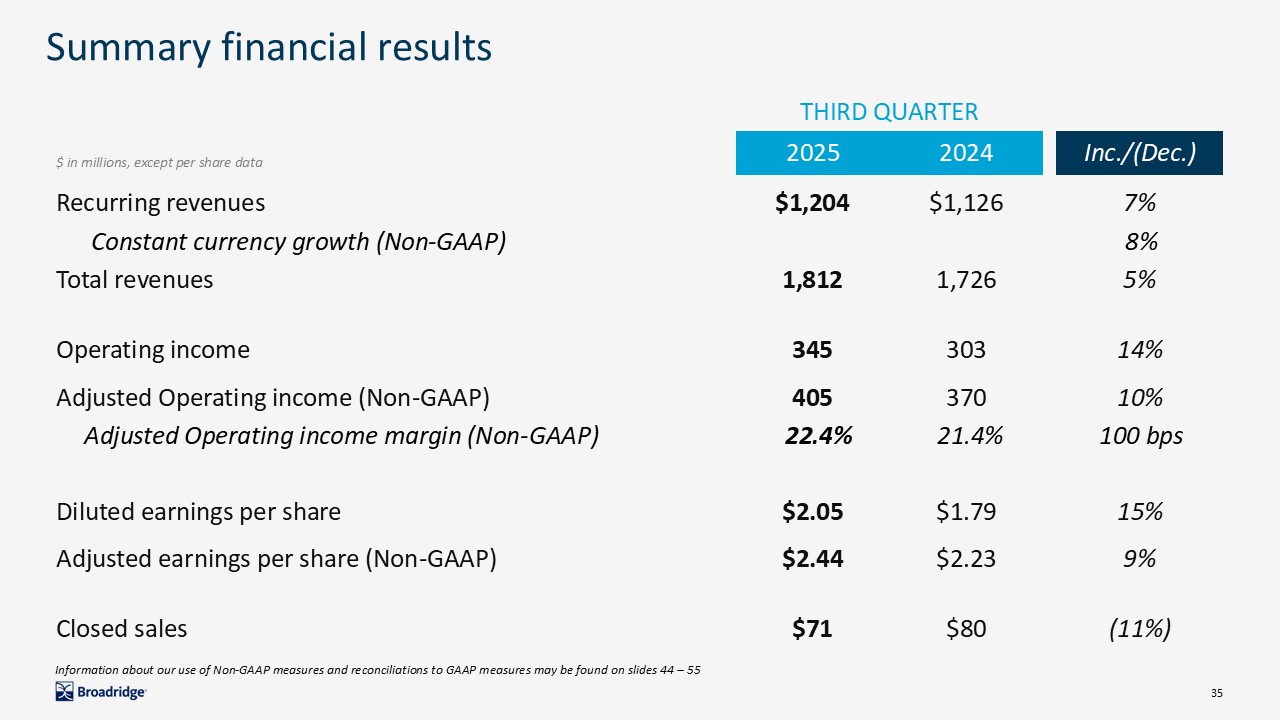
Summary financial results Third Quarter $ in millions, except per share
data 2025 2024 Inc./(Dec.) Recurring revenues $1,204 $1,126 7% Total revenues 1,812 1,726 5% Operating income 345 303 14% Adjusted Operating income (Non-GAAP) 405 370 10% Diluted earnings per share
$2.05 $1.79 15% Adjusted earnings per share (Non-GAAP) $2.44 $2.23 9% Closed sales $71 $80 (11%) Constant currency growth (Non-GAAP) 8% Adjusted Operating income margin (Non-GAAP) 22.4% 21.4% 100 bps Information about our
use of Non-GAAP measures and reconciliations to GAAP measures may be found on slides 44 – 55
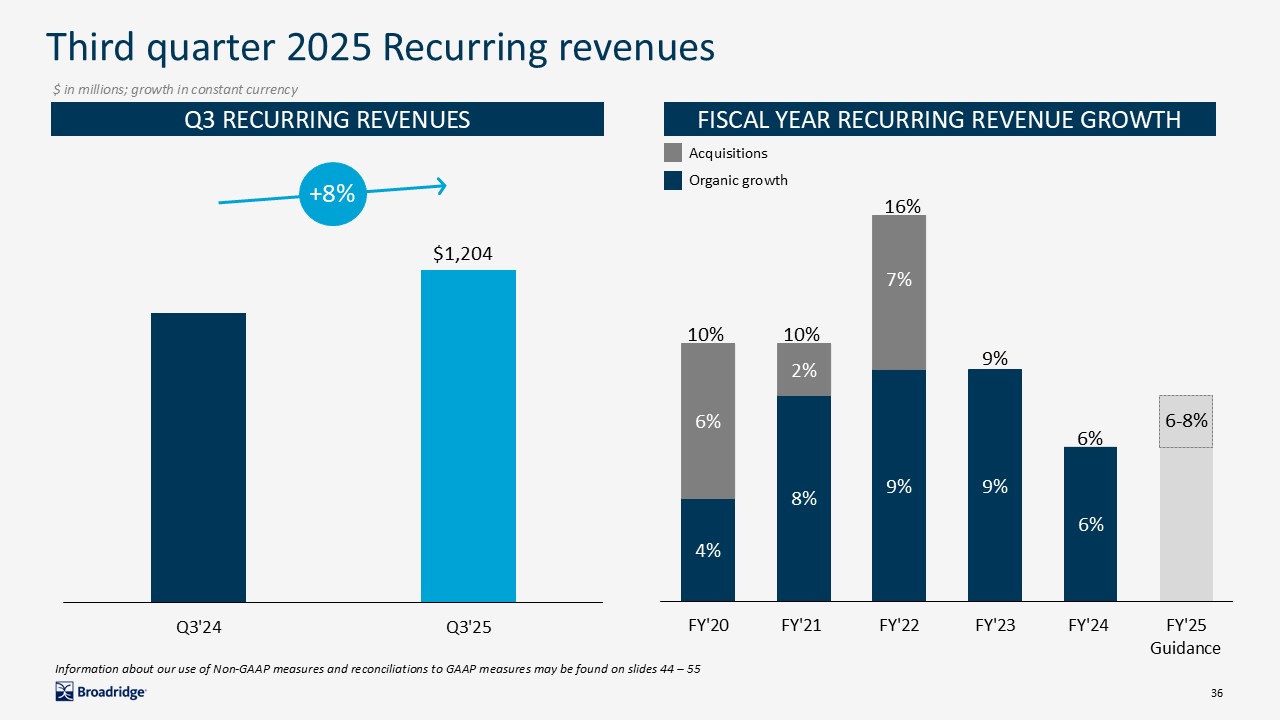
$1,204 +8% 16% 10% 9% Third quarter 2025 Recurring revenues Q3 Recurring
Revenues Fiscal Year Recurring Revenue growth $ in millions; growth in constant currency Information about our use of Non-GAAP measures and reconciliations to GAAP measures may be found on slides 44 – 55 Acquisitions Organic growth
6% 6-8% 10%
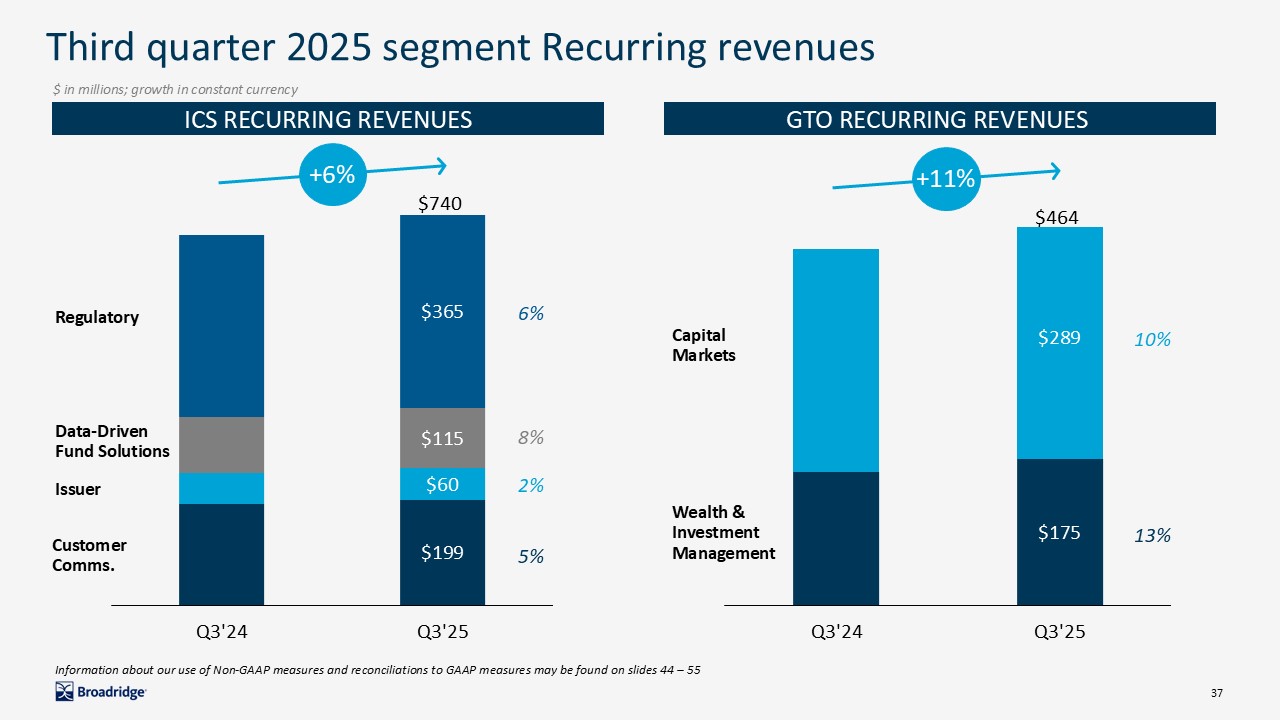
Third quarter 2025 segment Recurring revenues Regulatory Customer
Comms. Data-Driven Fund Solutions Issuer 2% 5% 8% 6% ICS Recurring Revenues Gto recurring Revenues $740 $ in millions; growth in constant currency Information about our use of Non-GAAP measures and reconciliations to GAAP measures
may be found on slides 44 – 55 Capital Markets Wealth & Investment Management $464 10% 13% +6% +11%
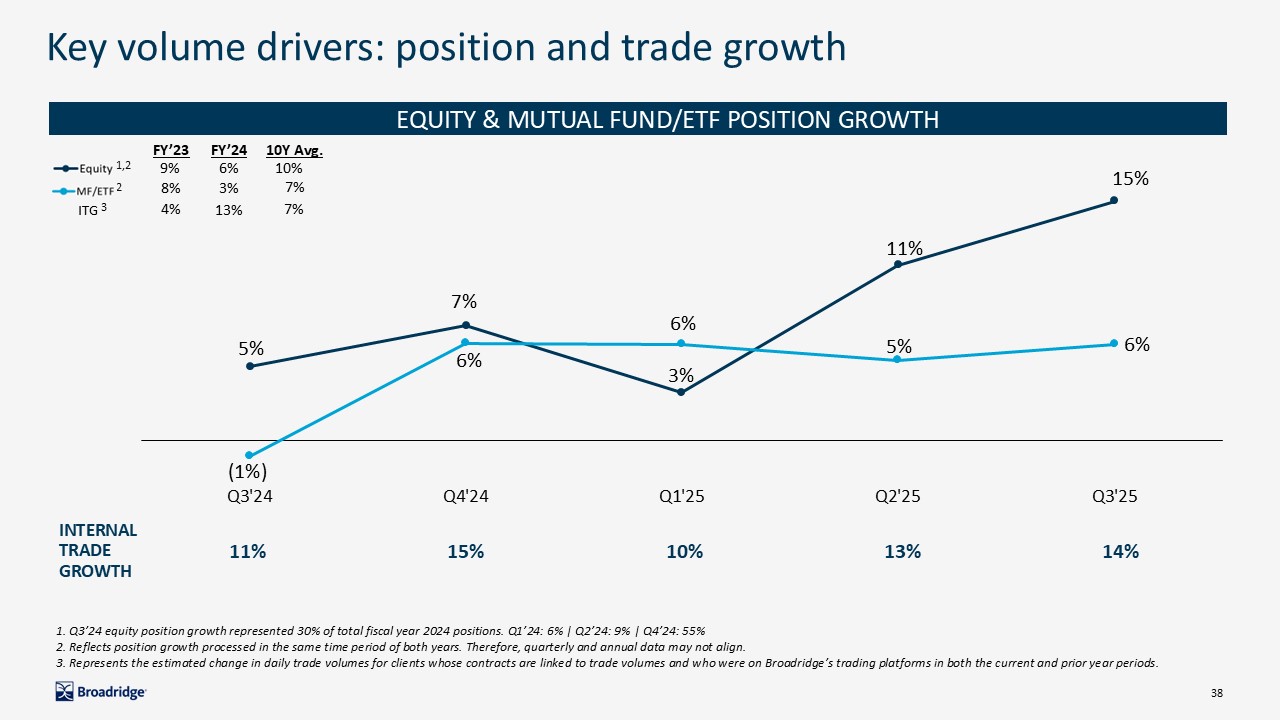
Key volume drivers: position and trade growth 11% 15% 10% 13% 14% internal
trade growth EQUITY & MUTUAL FUND/ETF POSITION GROWTH 1. Q3’24 equity position growth represented 30% of total fiscal year 2024 positions. Q1’24: 6% | Q2’24: 9% | Q4’24: 55% 2. Reflects position growth processed in the same time period
of both years. Therefore, quarterly and annual data may not align. 3. Represents the estimated change in daily trade volumes for clients whose contracts are linked to trade volumes and who were on Broadridge’s trading platforms in both the
current and prior year periods. ITG 3 FY’23 FY’24 6% 3% 9% 8% 13% 4% 10% 10Y Avg. 7% 7% 2 1,2
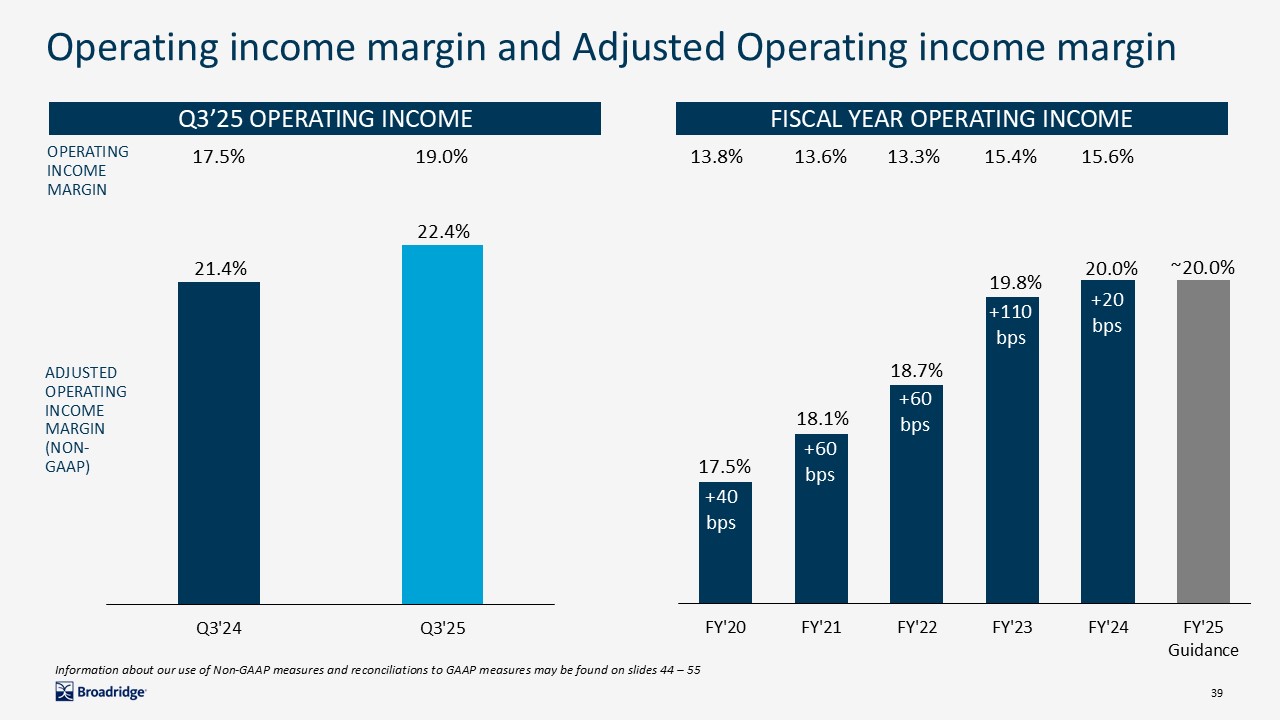
Operating income margin and Adjusted Operating income
margin 13.3% 15.4% 15.6% 19.0% 17.5% +60 bps +60 bps OPERATING INCOME MARGIN ADJUSTED OPERATING INCOME MARGIN (Non-GAAP) 22.4% +110 bps ~20.0% 21.4% Information about our use of Non-GAAP measures and reconciliations
to GAAP measures may be found on slides 44 – 55 +20 bps Q3’25 operating income Fiscal Year operating income 20.0% 13.6% 13.8% +40 bps
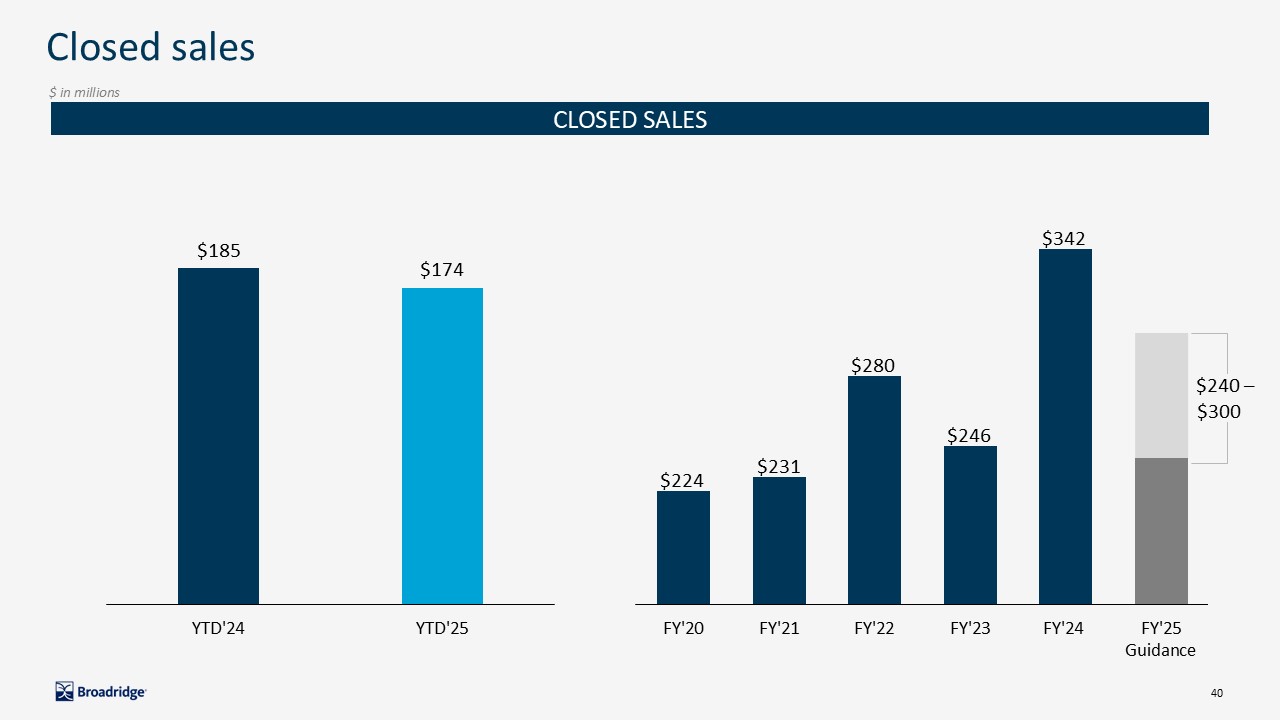
Closed sales $ in millions $246 $185 $174 $342 $280 CLOSED SALES $231
$240 – $300 $224
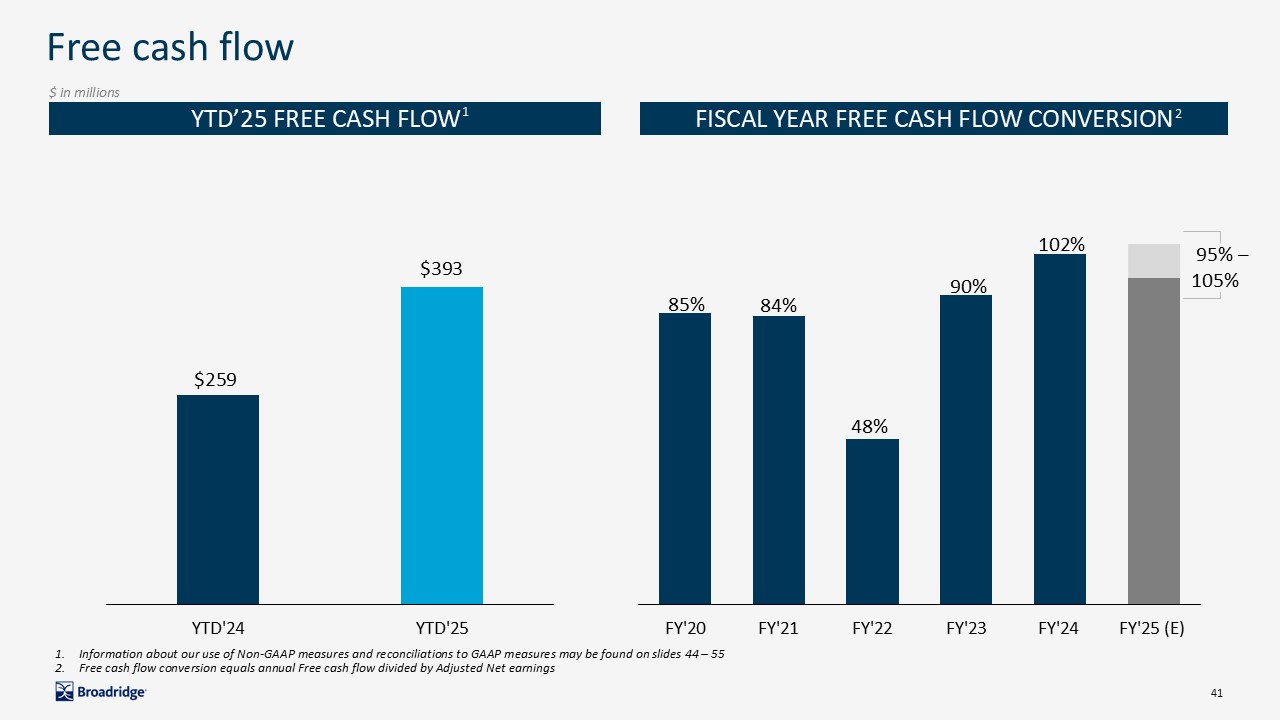
Free cash flow $ in millions Ytd’25 free cash flow Fiscal Year free cash flow
conversion Information about our use of Non-GAAP measures and reconciliations to GAAP measures may be found on slides 44 – 55 Free cash flow conversion equals annual Free cash flow divided by Adjusted Net earnings 1 2 95% – 105%
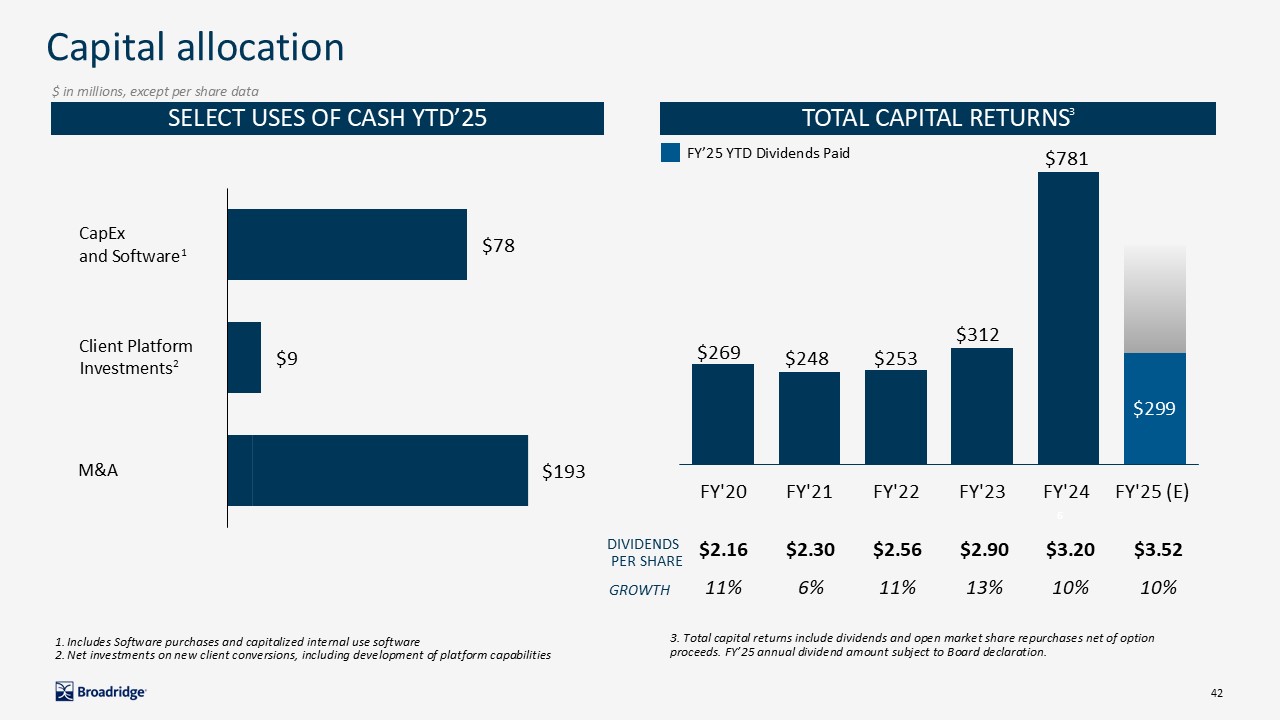
Select uses of cash YTD’25 Total Capital Returns Capital allocation $ in
millions, except per share data $2.16 $2.30 $2.56 $2.90 $3.20 $3.52 11% 6% 11% 13% 10% 10% Dividends per share 2 Includes Software purchases and capitalized internal use software Net investments on new client conversions,
including development of platform capabilities 1 $9 $78 $193 6 3. Total capital returns include dividends and open market share repurchases net of option proceeds. FY’25 annual dividend amount subject to Board
declaration. growth 6 6 $253 $248 $312 3 $781 FY’25 YTD Dividends Paid $269

Explanation of Non-GAAP Measures and reconciliation of GAAP to Non-GAAP Measures
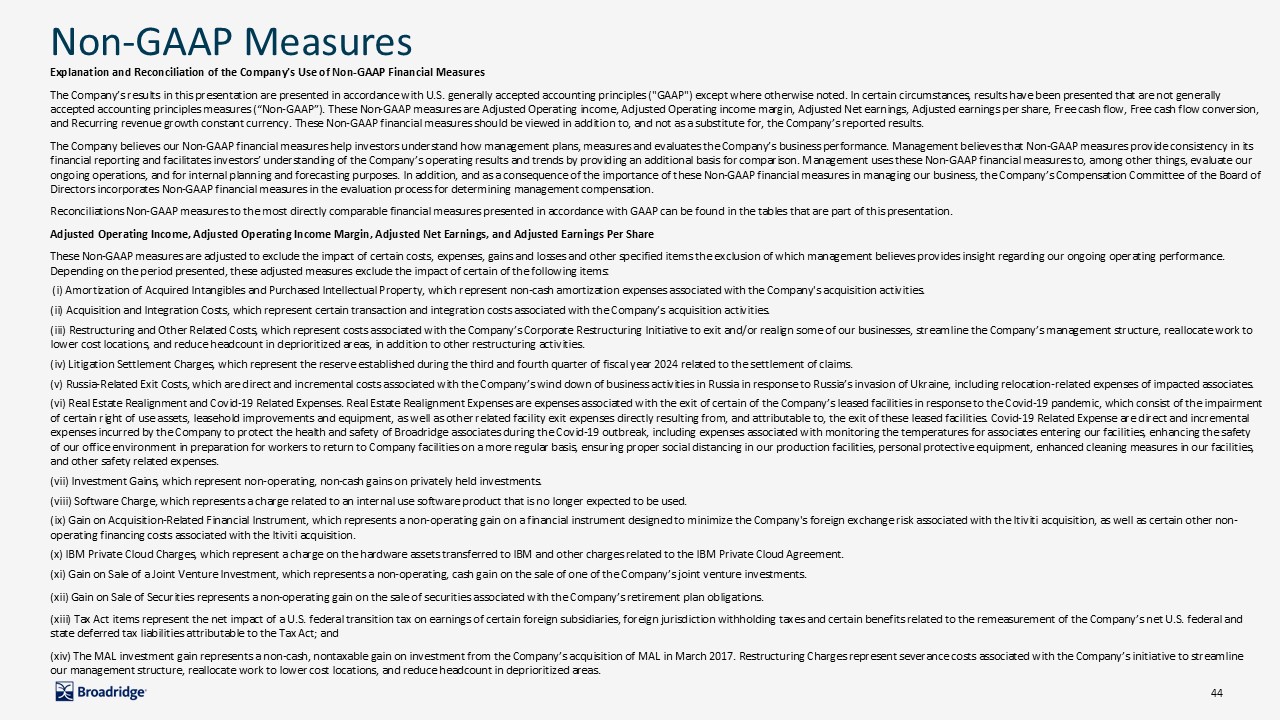
Non-GAAP Measures Explanation and Reconciliation of the Company’s Use of Non-GAAP
Financial Measures The Company’s results in this presentation are presented in accordance with U.S. generally accepted accounting principles ("GAAP") except where otherwise noted. In certain circumstances, results have been presented that are
not generally accepted accounting principles measures (“Non-GAAP”). These Non-GAAP measures are Adjusted Operating income, Adjusted Operating income margin, Adjusted Net earnings, Adjusted earnings per share, Free cash flow, Free cash flow
conversion, and Recurring revenue growth constant currency. These Non-GAAP financial measures should be viewed in addition to, and not as a substitute for, the Company’s reported results. The Company believes our Non-GAAP financial measures
help investors understand how management plans, measures and evaluates the Company’s business performance. Management believes that Non-GAAP measures provide consistency in its financial reporting and facilitates investors’ understanding of the
Company’s operating results and trends by providing an additional basis for comparison. Management uses these Non-GAAP financial measures to, among other things, evaluate our ongoing operations, and for internal planning and forecasting
purposes. In addition, and as a consequence of the importance of these Non-GAAP financial measures in managing our business, the Company’s Compensation Committee of the Board of Directors incorporates Non-GAAP financial measures in the
evaluation process for determining management compensation. Reconciliations Non-GAAP measures to the most directly comparable financial measures presented in accordance with GAAP can be found in the tables that are part of this
presentation. Adjusted Operating Income, Adjusted Operating Income Margin, Adjusted Net Earnings, and Adjusted Earnings Per Share These Non-GAAP measures are adjusted to exclude the impact of certain costs, expenses, gains and losses and
other specified items the exclusion of which management believes provides insight regarding our ongoing operating performance. Depending on the period presented, these adjusted measures exclude the impact of certain of the following items:
(i) Amortization of Acquired Intangibles and Purchased Intellectual Property, which represent non-cash amortization expenses associated with the Company's acquisition activities. (ii) Acquisition and Integration Costs, which represent certain
transaction and integration costs associated with the Company’s acquisition activities. (iii) Restructuring and Other Related Costs, which represent costs associated with the Company’s Corporate Restructuring Initiative to exit and/or realign
some of our businesses, streamline the Company’s management structure, reallocate work to lower cost locations, and reduce headcount in deprioritized areas, in addition to other restructuring activities. (iv) Litigation Settlement Charges,
which represent the reserve established during the third and fourth quarter of fiscal year 2024 related to the settlement of claims. (v) Russia-Related Exit Costs, which are direct and incremental costs associated with the Company’s wind down
of business activities in Russia in response to Russia’s invasion of Ukraine, including relocation-related expenses of impacted associates. (vi) Real Estate Realignment and Covid-19 Related Expenses. Real Estate Realignment Expenses are
expenses associated with the exit of certain of the Company’s leased facilities in response to the Covid-19 pandemic, which consist of the impairment of certain right of use assets, leasehold improvements and equipment, as well as other related
facility exit expenses directly resulting from, and attributable to, the exit of these leased facilities. Covid-19 Related Expense are direct and incremental expenses incurred by the Company to protect the health and safety of Broadridge
associates during the Covid-19 outbreak, including expenses associated with monitoring the temperatures for associates entering our facilities, enhancing the safety of our office environment in preparation for workers to return to Company
facilities on a more regular basis, ensuring proper social distancing in our production facilities, personal protective equipment, enhanced cleaning measures in our facilities, and other safety related expenses. (vii) Investment Gains, which
represent non-operating, non-cash gains on privately held investments. (viii) Software Charge, which represents a charge related to an internal use software product that is no longer expected to be used. (ix) Gain on Acquisition-Related
Financial Instrument, which represents a non-operating gain on a financial instrument designed to minimize the Company's foreign exchange risk associated with the Itiviti acquisition, as well as certain other non-operating financing costs
associated with the Itiviti acquisition. (x) IBM Private Cloud Charges, which represent a charge on the hardware assets transferred to IBM and other charges related to the IBM Private Cloud Agreement. (xi) Gain on Sale of a Joint Venture
Investment, which represents a non-operating, cash gain on the sale of one of the Company’s joint venture investments. (xii) Gain on Sale of Securities represents a non-operating gain on the sale of securities associated with the Company’s
retirement plan obligations. (xiii) Tax Act items represent the net impact of a U.S. federal transition tax on earnings of certain foreign subsidiaries, foreign jurisdiction withholding taxes and certain benefits related to the remeasurement
of the Company’s net U.S. federal and state deferred tax liabilities attributable to the Tax Act; and (xiv) The MAL investment gain represents a non-cash, nontaxable gain on investment from the Company’s acquisition of MAL in March 2017.
Restructuring Charges represent severance costs associated with the Company’s initiative to streamline our management structure, reallocate work to lower cost locations, and reduce headcount in deprioritized areas.
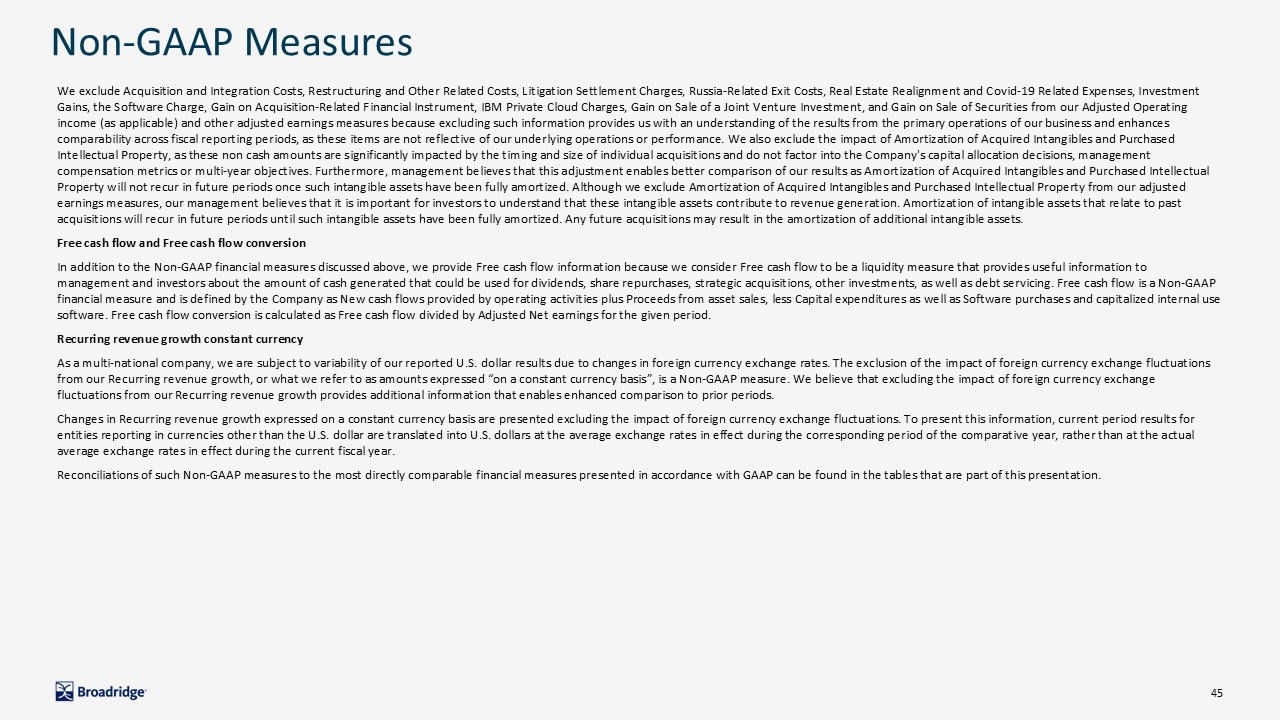
We exclude Acquisition and Integration Costs, Restructuring and Other Related
Costs, Litigation Settlement Charges, Russia-Related Exit Costs, Real Estate Realignment and Covid-19 Related Expenses, Investment Gains, the Software Charge, Gain on Acquisition-Related Financial Instrument, IBM Private Cloud Charges, Gain on
Sale of a Joint Venture Investment, and Gain on Sale of Securities from our Adjusted Operating income (as applicable) and other adjusted earnings measures because excluding such information provides us with an understanding of the results from
the primary operations of our business and enhances comparability across fiscal reporting periods, as these items are not reflective of our underlying operations or performance. We also exclude the impact of Amortization of Acquired Intangibles
and Purchased Intellectual Property, as these non cash amounts are significantly impacted by the timing and size of individual acquisitions and do not factor into the Company's capital allocation decisions, management compensation metrics or
multi-year objectives. Furthermore, management believes that this adjustment enables better comparison of our results as Amortization of Acquired Intangibles and Purchased Intellectual Property will not recur in future periods once such
intangible assets have been fully amortized. Although we exclude Amortization of Acquired Intangibles and Purchased Intellectual Property from our adjusted earnings measures, our management believes that it is important for investors to
understand that these intangible assets contribute to revenue generation. Amortization of intangible assets that relate to past acquisitions will recur in future periods until such intangible assets have been fully amortized. Any future
acquisitions may result in the amortization of additional intangible assets. Free cash flow and Free cash flow conversion In addition to the Non-GAAP financial measures discussed above, we provide Free cash flow information because we
consider Free cash flow to be a liquidity measure that provides useful information to management and investors about the amount of cash generated that could be used for dividends, share repurchases, strategic acquisitions, other investments, as
well as debt servicing. Free cash flow is a Non-GAAP financial measure and is defined by the Company as New cash flows provided by operating activities plus Proceeds from asset sales, less Capital expenditures as well as Software purchases and
capitalized internal use software. Free cash flow conversion is calculated as Free cash flow divided by Adjusted Net earnings for the given period. Recurring revenue growth constant currency As a multi-national company, we are subject to
variability of our reported U.S. dollar results due to changes in foreign currency exchange rates. The exclusion of the impact of foreign currency exchange fluctuations from our Recurring revenue growth, or what we refer to as amounts expressed
“on a constant currency basis”, is a Non-GAAP measure. We believe that excluding the impact of foreign currency exchange fluctuations from our Recurring revenue growth provides additional information that enables enhanced comparison to prior
periods. Changes in Recurring revenue growth expressed on a constant currency basis are presented excluding the impact of foreign currency exchange fluctuations. To present this information, current period results for entities reporting in
currencies other than the U.S. dollar are translated into U.S. dollars at the average exchange rates in effect during the corresponding period of the comparative year, rather than at the actual average exchange rates in effect during the
current fiscal year. Reconciliations of such Non-GAAP measures to the most directly comparable financial measures presented in accordance with GAAP can be found in the tables that are part of this presentation. Non-GAAP Measures
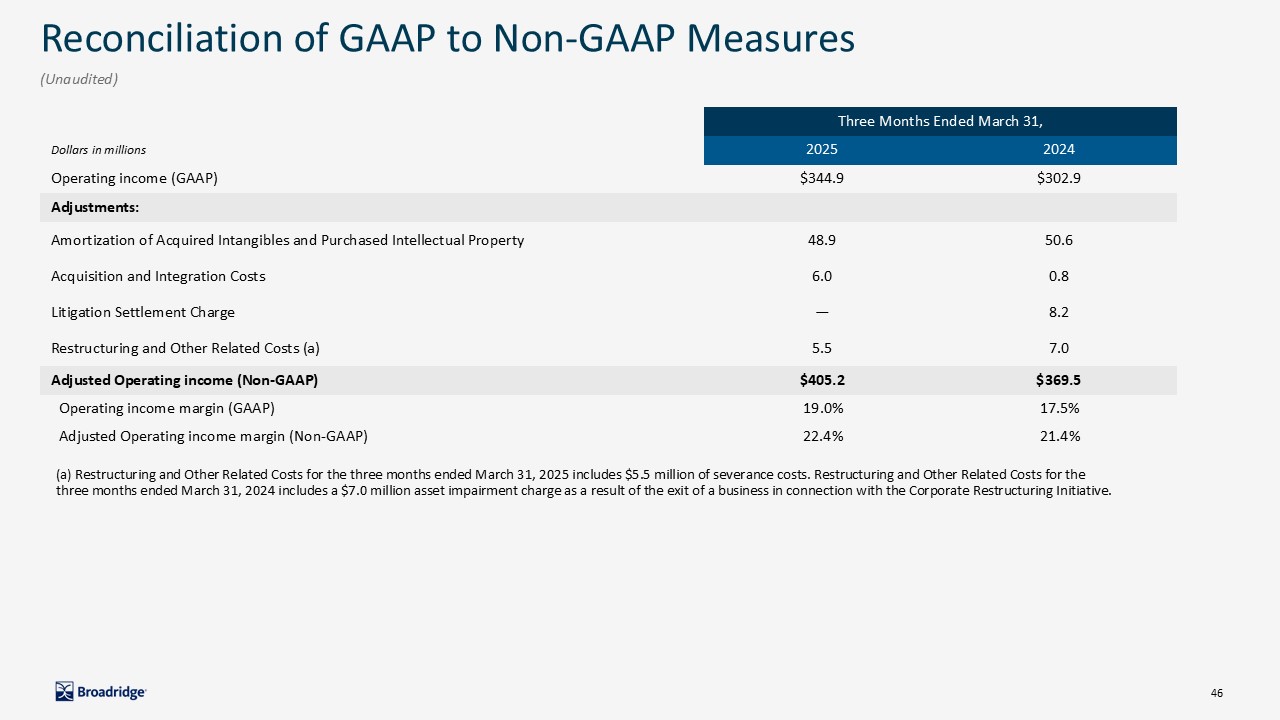
Reconciliation of GAAP to Non-GAAP Measures (Unaudited) Three Months Ended March
31, Dollars in millions 2025 2024 Operating income (GAAP) $344.9 $302.9 Adjustments: Amortization of Acquired Intangibles and Purchased Intellectual Property 48.9 50.6 Acquisition and Integration Costs 6.0 0.8 Litigation
Settlement Charge — 8.2 Restructuring and Other Related Costs (a) 5.5 7.0 Adjusted Operating income (Non-GAAP) $405.2 $369.5 Operating income margin (GAAP) 19.0% 17.5% Adjusted Operating income margin (Non-GAAP) 22.4% 21.4% (a)
Restructuring and Other Related Costs for the three months ended March 31, 2025 includes $5.5 million of severance costs. Restructuring and Other Related Costs for the three months ended March 31, 2024 includes a $7.0 million asset impairment
charge as a result of the exit of a business in connection with the Corporate Restructuring Initiative.
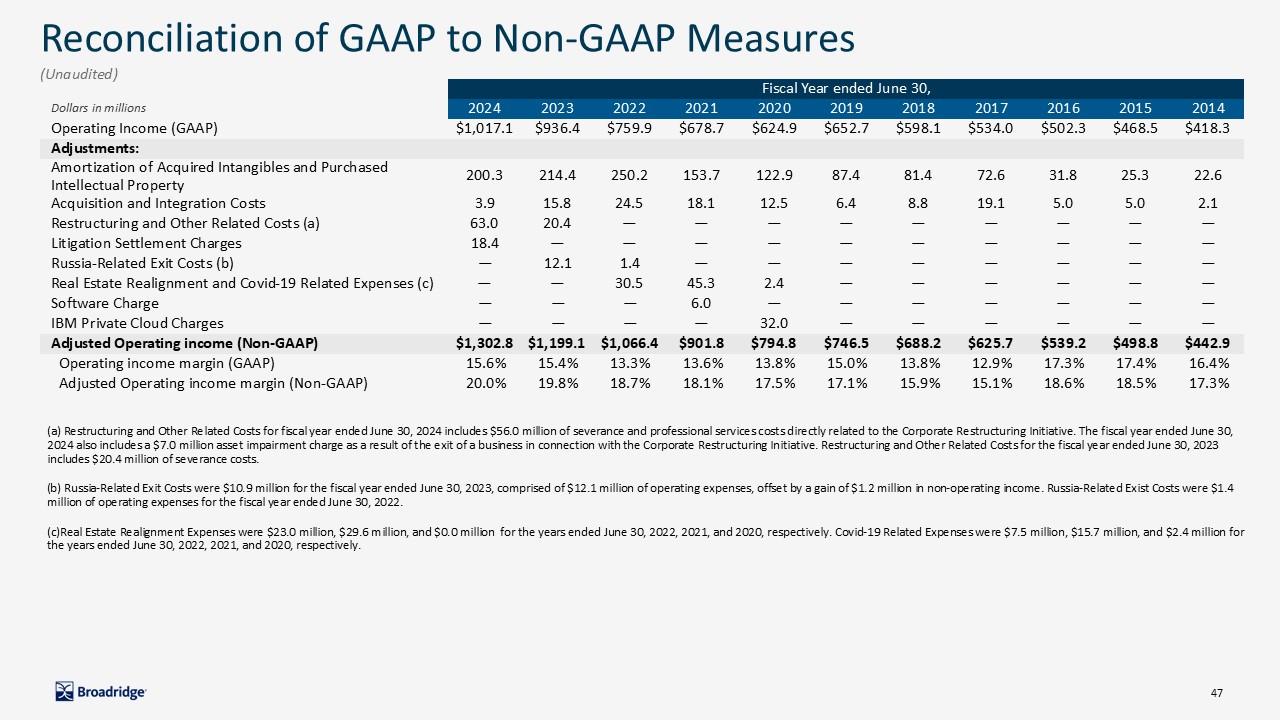
Reconciliation of GAAP to Non-GAAP Measures Fiscal Year ended June 30, Year
ended June 30, Year ended June 30, Dollars in millions 2024 2023 2022 2021 2020 2019 2018 2017 2016 2015 2014 Operating Income
(GAAP) $1,017.1 $936.4 $759.9 $678.7 $624.9 $652.7 $598.1 $534.0 $502.3 $468.5 $418.3 Adjustments: Amortization of Acquired Intangibles and Purchased Intellectual
Property 200.3 214.4 250.2 153.7 122.9 87.4 81.4 72.6 31.8 25.3 22.6 Acquisition and Integration Costs 3.9 15.8 24.5 18.1 12.5 6.4 8.8 19.1 5.0 5.0 2.1 Restructuring and Other Related Costs
(a) 63.0 20.4 — — — — — — — — — Litigation Settlement Charges 18.4 — — — — — — — — — — Russia-Related Exit Costs (b) — 12.1 1.4 — — — — — — — — Real Estate Realignment and Covid-19 Related Expenses
(c) — — 30.5 45.3 2.4 — — — — — — Software Charge — — — 6.0 — — — — — — — IBM Private Cloud Charges — — — — 32.0 — — — — — — Adjusted Operating income
(Non-GAAP) $1,302.8 $1,199.1 $1,066.4 $901.8 $794.8 $746.5 $688.2 $625.7 $539.2 $498.8 $442.9 Operating income margin (GAAP) 15.6% 15.4% 13.3% 13.6% 13.8% 15.0% 13.8% 12.9% 17.3% 17.4% 16.4% Adjusted Operating income
margin (Non-GAAP) 20.0% 19.8% 18.7% 18.1% 17.5% 17.1% 15.9% 15.1% 18.6% 18.5% 17.3% (Unaudited) (a) Restructuring and Other Related Costs for fiscal year ended June 30, 2024 includes $56.0 million of severance and professional
services costs directly related to the Corporate Restructuring Initiative. The fiscal year ended June 30, 2024 also includes a $7.0 million asset impairment charge as a result of the exit of a business in connection with the Corporate
Restructuring Initiative. Restructuring and Other Related Costs for the fiscal year ended June 30, 2023 includes $20.4 million of severance costs. (b) Russia-Related Exit Costs were $10.9 million for the fiscal year ended June 30, 2023,
comprised of $12.1 million of operating expenses, offset by a gain of $1.2 million in non-operating income. Russia-Related Exist Costs were $1.4 million of operating expenses for the fiscal year ended June 30, 2022. (c)Real Estate Realignment
Expenses were $23.0 million, $29.6 million, and $0.0 million for the years ended June 30, 2022, 2021, and 2020, respectively. Covid-19 Related Expenses were $7.5 million, $15.7 million, and $2.4 million for the years ended June 30, 2022, 2021,
and 2020, respectively.
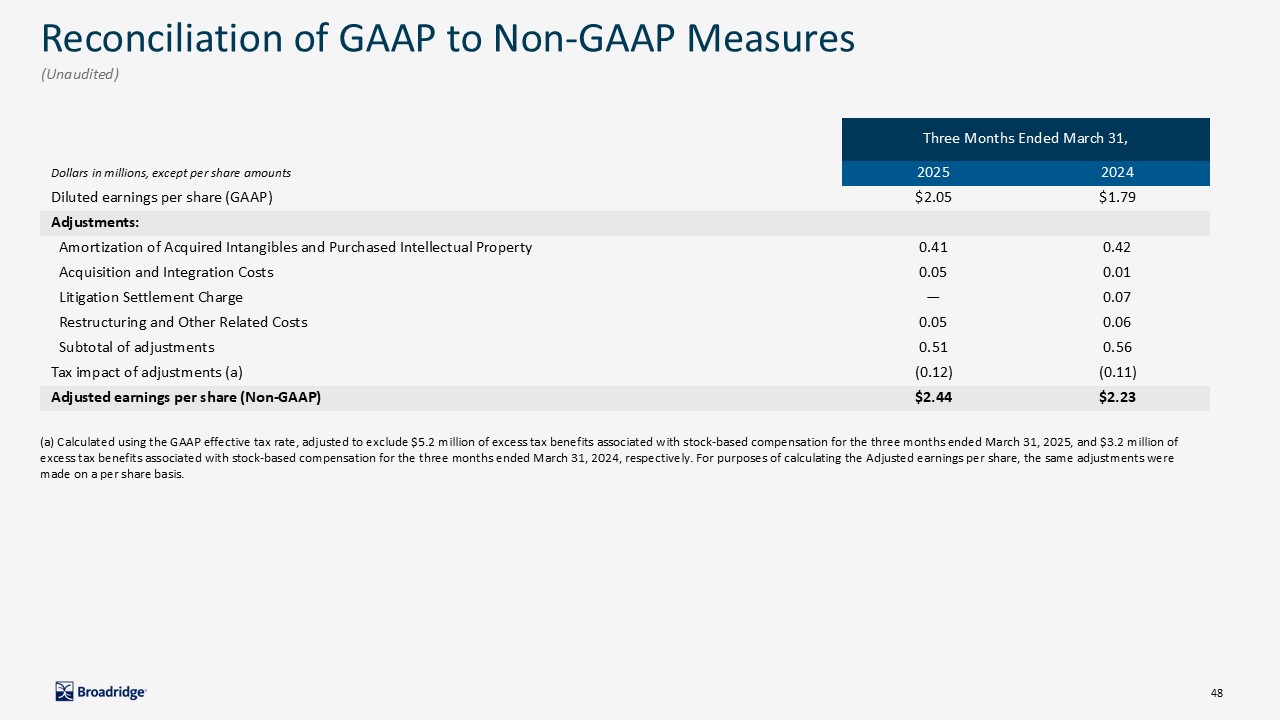
Reconciliation of GAAP to Non-GAAP Measures (Unaudited) Three Months Ended March
31, Dollars in millions, except per share amounts 2025 2024 Diluted earnings per share (GAAP) $2.05 $1.79 Adjustments: Amortization of Acquired Intangibles and Purchased Intellectual Property 0.41 0.42 Acquisition and Integration
Costs 0.05 0.01 Litigation Settlement Charge — 0.07 Restructuring and Other Related Costs 0.05 0.06 Subtotal of adjustments 0.51 0.56 Tax impact of adjustments (a) (0.12) (0.11) Adjusted earnings per share
(Non-GAAP) $2.44 $2.23 (a) Calculated using the GAAP effective tax rate, adjusted to exclude $5.2 million of excess tax benefits associated with stock-based compensation for the three months ended March 31, 2025, and $3.2 million of excess
tax benefits associated with stock-based compensation for the three months ended March 31, 2024, respectively. For purposes of calculating the Adjusted earnings per share, the same adjustments were made on a per share basis.
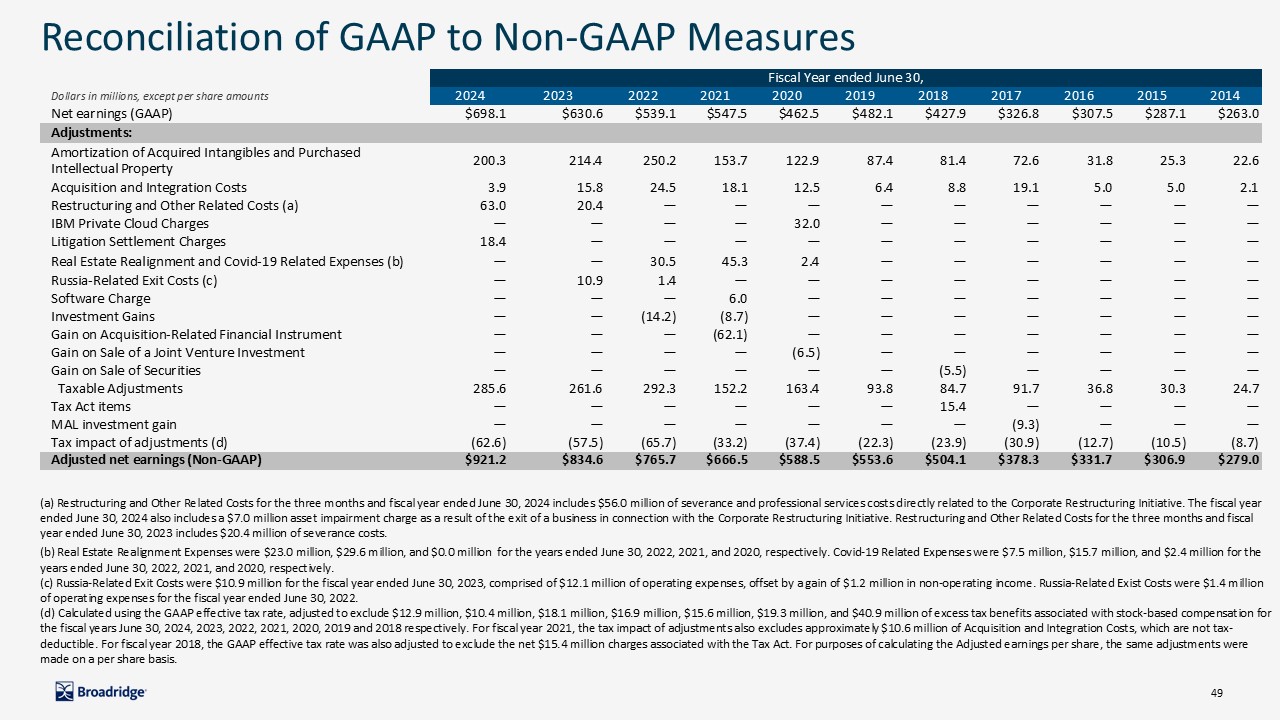
(a) Restructuring and Other Related Costs for the three months and fiscal year
ended June 30, 2024 includes $56.0 million of severance and professional services costs directly related to the Corporate Restructuring Initiative. The fiscal year ended June 30, 2024 also includes a $7.0 million asset impairment charge as a
result of the exit of a business in connection with the Corporate Restructuring Initiative. Restructuring and Other Related Costs for the three months and fiscal year ended June 30, 2023 includes $20.4 million of severance costs. (b) Real
Estate Realignment Expenses were $23.0 million, $29.6 million, and $0.0 million for the years ended June 30, 2022, 2021, and 2020, respectively. Covid-19 Related Expenses were $7.5 million, $15.7 million, and $2.4 million for the years ended
June 30, 2022, 2021, and 2020, respectively.(c) Russia-Related Exit Costs were $10.9 million for the fiscal year ended June 30, 2023, comprised of $12.1 million of operating expenses, offset by a gain of $1.2 million in non-operating income.
Russia-Related Exist Costs were $1.4 million of operating expenses for the fiscal year ended June 30, 2022.(d) Calculated using the GAAP effective tax rate, adjusted to exclude $12.9 million, $10.4 million, $18.1 million, $16.9 million, $15.6
million, $19.3 million, and $40.9 million of excess tax benefits associated with stock-based compensation for the fiscal years June 30, 2024, 2023, 2022, 2021, 2020, 2019 and 2018 respectively. For fiscal year 2021, the tax impact of
adjustments also excludes approximately $10.6 million of Acquisition and Integration Costs, which are not tax-deductible. For fiscal year 2018, the GAAP effective tax rate was also adjusted to exclude the net $15.4 million charges associated
with the Tax Act. For purposes of calculating the Adjusted earnings per share, the same adjustments were made on a per share basis. Fiscal Year ended June 30, Year ended June 30, Year ended June 30, Fiscal Year Ended June 30 Dollars in
millions, except per share amounts 2024 2023 2022 2021 2020 2019 2018 2017 2016 2015 2014 Net earnings (GAAP) $698.1 $630.6 $539.1 $547.5 $462.5 $482.1 $427.9 $326.8 $307.5 $287.1 $263.0 Adjustments: Amortization of
Acquired Intangibles and Purchased Intellectual Property 200.3 214.4 250.2 153.7 122.9 87.4 81.4 72.6 31.8 25.3 22.6 Acquisition and Integration Costs 3.9 15.8 24.5 18.1 12.5 6.4 8.8 19.1 5.0 5.0 2.1 Restructuring and
Other Related Costs (a) 63.0 20.4 — — — — — — — — — IBM Private Cloud Charges — — — — 32.0 — — — — — — Litigation Settlement Charges 18.4 — — — — — — — — — — Real Estate Realignment and Covid-19 Related
Expenses (b) — — 30.5 45.3 2.4 — — — — — — Russia-Related Exit Costs (c) — 10.9 1.4 — — — — — — — — Software Charge — — — 6.0 — — — — — — — Investment Gains — — (14.2) (8.7) — — — — — — — Gain on
Acquisition-Related Financial Instrument — — — (62.1) — — — — — — — Gain on Sale of a Joint Venture Investment — — — — (6.5) — — — — — — Gain on Sale of Securities — — — — — — (5.5) — — — — Taxable
Adjustments 285.6 261.6 292.3 152.2 163.4 93.8 84.7 91.7 36.8 30.3 24.7 Tax Act items — — — — — — 15.4 — — — — MAL investment gain — — — — — — — (9.3) — — — Tax impact of adjustments
(d) (62.6) (57.5) (65.7) (33.2) (37.4) (22.3) (23.9) (30.9) (12.7) (10.5) (8.7) Adjusted net earnings (Non-GAAP) $921.2 $834.6 $765.7 $666.5 $588.5 $553.6 $504.1 $378.3 $331.7 $306.9 $279.0 Reconciliation of GAAP to
Non-GAAP Measures
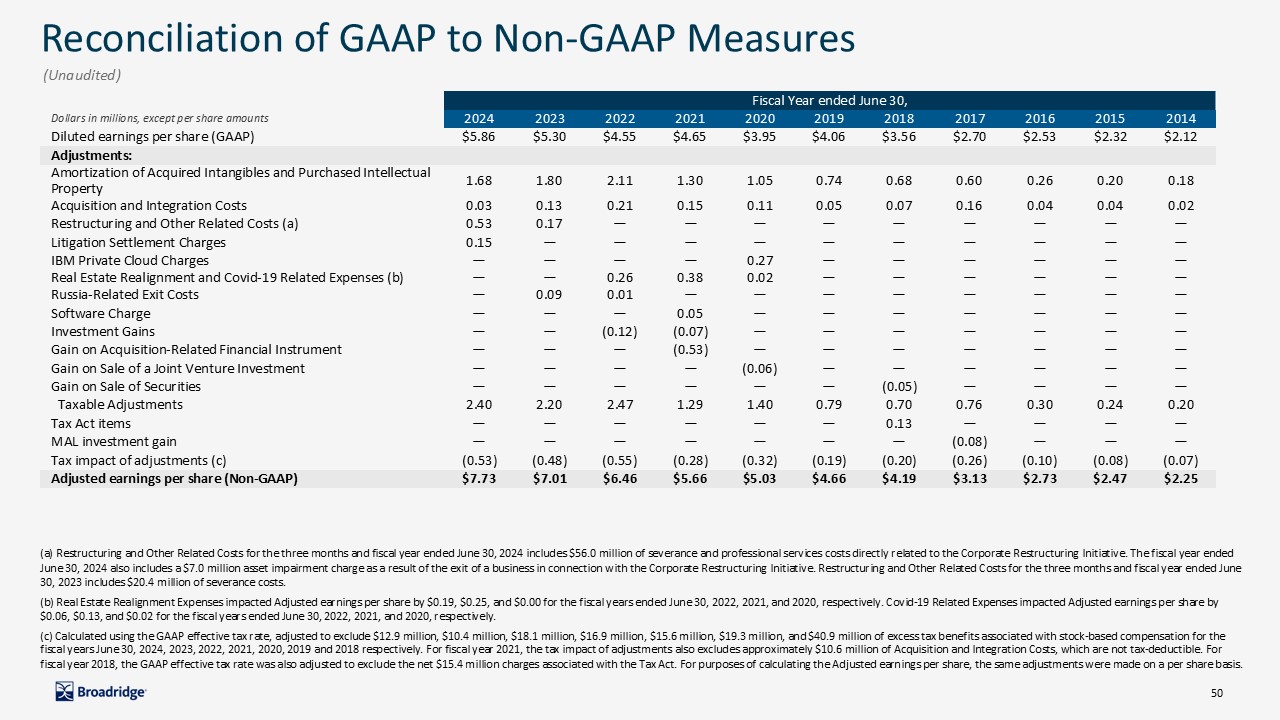
Reconciliation of GAAP to Non-GAAP Measures (Unaudited) Fiscal Year ended June
30, Year ended June 30, Year ended June 30, Fiscal Year Ended June 30 Dollars in millions, except per share amounts 2024 2023 2022 2021 2020 2019 2018 2017 2016 2015 2014 Diluted earnings per share
(GAAP) $5.86 $5.30 $4.55 $4.65 $3.95 $4.06 $3.56 $2.70 $2.53 $2.32 $2.12 Adjustments: Amortization of Acquired Intangibles and Purchased Intellectual
Property 1.68 1.80 2.11 1.30 1.05 0.74 0.68 0.60 0.26 0.20 0.18 Acquisition and Integration Costs 0.03 0.13 0.21 0.15 0.11 0.05 0.07 0.16 0.04 0.04 0.02 Restructuring and Other Related Costs
(a) 0.53 0.17 — — — — — — — — — Litigation Settlement Charges 0.15 — — — — — — — — — — IBM Private Cloud Charges — — — — 0.27 — — — — — — Real Estate Realignment and Covid-19 Related Expenses
(b) — — 0.26 0.38 0.02 — — — — — — Russia-Related Exit Costs — 0.09 0.01 — — — — — — — — Software Charge — — — 0.05 — — — — — — — Investment Gains — — (0.12) (0.07) — — — — — — — Gain on
Acquisition-Related Financial Instrument — — — (0.53) — — — — — — — Gain on Sale of a Joint Venture Investment — — — — (0.06) — — — — — — Gain on Sale of Securities — — — — — — (0.05) — — — — Taxable
Adjustments 2.40 2.20 2.47 1.29 1.40 0.79 0.70 0.76 0.30 0.24 0.20 Tax Act items — — — — — — 0.13 — — — — MAL investment gain — — — — — — — (0.08) — — — Tax impact of adjustments
(c) (0.53) (0.48) (0.55) (0.28) (0.32) (0.19) (0.20) (0.26) (0.10) (0.08) (0.07) Adjusted earnings per share (Non-GAAP) $7.73 $7.01 $6.46 $5.66 $5.03 $4.66 $4.19 $3.13 $2.73 $2.47 $2.25 (a) Restructuring and Other
Related Costs for the three months and fiscal year ended June 30, 2024 includes $56.0 million of severance and professional services costs directly related to the Corporate Restructuring Initiative. The fiscal year ended June 30, 2024 also
includes a $7.0 million asset impairment charge as a result of the exit of a business in connection with the Corporate Restructuring Initiative. Restructuring and Other Related Costs for the three months and fiscal year ended June 30, 2023
includes $20.4 million of severance costs. (b) Real Estate Realignment Expenses impacted Adjusted earnings per share by $0.19, $0.25, and $0.00 for the fiscal years ended June 30, 2022, 2021, and 2020, respectively. Covid-19 Related Expenses
impacted Adjusted earnings per share by $0.06, $0.13, and $0.02 for the fiscal years ended June 30, 2022, 2021, and 2020, respectively. (c) Calculated using the GAAP effective tax rate, adjusted to exclude $12.9 million, $10.4 million, $18.1
million, $16.9 million, $15.6 million, $19.3 million, and $40.9 million of excess tax benefits associated with stock-based compensation for the fiscal years June 30, 2024, 2023, 2022, 2021, 2020, 2019 and 2018 respectively. For fiscal year
2021, the tax impact of adjustments also excludes approximately $10.6 million of Acquisition and Integration Costs, which are not tax-deductible. For fiscal year 2018, the GAAP effective tax rate was also adjusted to exclude the net $15.4
million charges associated with the Tax Act. For purposes of calculating the Adjusted earnings per share, the same adjustments were made on a per share basis.

Reconciliation of GAAP to Non-GAAP Measures (Unaudited) (a) Restructuring and
Other Related Costs for the three months ended March 31, 2025 includes $5.5 million of severance costs. Restructuring and Other Related Costs for the three months ended March 31, 2024 includes a $7.0 million asset impairment charge as a result
of the exit of a business in connection with the Corporate Restructuring Initiative. Restructuring and Other Related Costs for the fiscal year ended June 30, 2024 includes $56.0 million of severance and professional services costs directly
related to the Corporate Restructuring Initiative. The fiscal year ended June 30, 2024 also includes a $7.0 million asset impairment charge as a result of the exit of a business in connection with the Corporate Restructuring Initiative.
Restructuring and Other Related Costs for the fiscal year ended June 30, 2023 includes $20.4 million of severance costs. (b) Russia-Related Exit Costs were $10.9 million and $1.4 million for the fiscal years ended June 30, 2023 and June 30,
2022, comprised of $12.1 million of operating expenses, offset by a gain of $1.2 million in non-operating income for the fiscal year ended June 30, 2023, and $1.4 million of operating expenses for the fiscal year ended June 30, 2022. (c) Real
Estate Realignment Expenses were $23.0 million, $29.6 million, and $0.0 million for the fiscal years ended June 30, 2022, 2021, and 2020, respectively. Covid-19 Related Expenses were $7.5 million, $15.7, and $2.4 million for the fiscal years
ended June 30 2022, 2021, and 2020, respectively. (d) Calculated using the GAAP effective tax rate, adjusted to exclude $3.2 million and $6.3 million of excess tax benefits associated with stock-based compensation for the three months ended
December 31, 2024, and $1.2 million of excess tax benefits associated with stock based compensation for the three months ended December 31, 2023, respectively, and $12.9 million, $10.4 million, $18.1 million, $16.9 million and $15.6 million of
excess tax benefits associated with stock-based compensation for the fiscal year ended June 30, 2024, 2023, 2022, 2021, and 2020, respectively. (e) Free cash flow conversion is calculated as Free cash flow divided by Adjusted Net earnings for
the given period. Nine Months Ended March 31, Fiscal Year Ended June 30, Dollars in millions 2025 2024 2024 2023 2022 2021 2020 Net cash flows from operating activities (GAAP) $ 471.6 $ 335.2
$1,056.2 $823.3 $443.5 $640.1 $598.2 Capital expenditures and Software purchases and capitalized internal use software (78.5) (76.6) (113.0) (75.2) (73.1) (100.7) (98.7) Proceeds from asset sales — — — — —
18.0 — Free cash flow (Non-GAAP) $ 393.2 $258.6 $943.2 $748.2 $370.4 $557.3 $499.5 Three Months Ended March 31, Fiscal Year Ended June 30, Dollars in millions 2025 2024 2024 2023 2022 2021 2020 Net earnings
(GAAP) $243.1 $213.7 $698.1 $630.6 $539.1 $547.5 $462.5 Adjustments: Amortization of Acquired Intangibles and Purchased Intellectual Property 48.9 50.6 200.3 214.4 250.2 153.7 122.9 Acquisition and Integration Costs 6.0
0.8 3.9 15.8 24.5 18.1 12.5 Restructuring and Other Related Costs (a) 5.5 7.0 63.0 20.4 — — — Litigation Settlement Charges — 8.2 18.4 — — — — Russia-Related Exit Costs (b) — — — 10.9
1.4 — — Real Estate Realignment and Covid-19 Related Expenses (c) — — — — 30.5 45.3 2.4 Investment Gains — — — — (14.2) (8.7) — Software Charge — — — — — 6.0 — Gain on
Acquisition-Related Financial Instrument — — — — — (62.1) — IBM Private Cloud Charges — — — — — — 32.0 Gain on Sale of a Joint Venture Investment — — — — — — (6.5) Subtotal of
adjustments 60.4 66.6 285.6 261.6 292.3 152.2 163.4 Tax impact of adjustments (d) (14.6) (13.5) (62.6) (57.5) (65.7) (33.2) (37.4) Adjusted Net earnings
(Non-GAAP) $288.8 $266.8 $921.2 $834.6 $765.7 $666.5 $588.5 LTM Free cash flow conversion (Non-GAAP) (e) 102 % 90 % 48 % 84 % 85 %
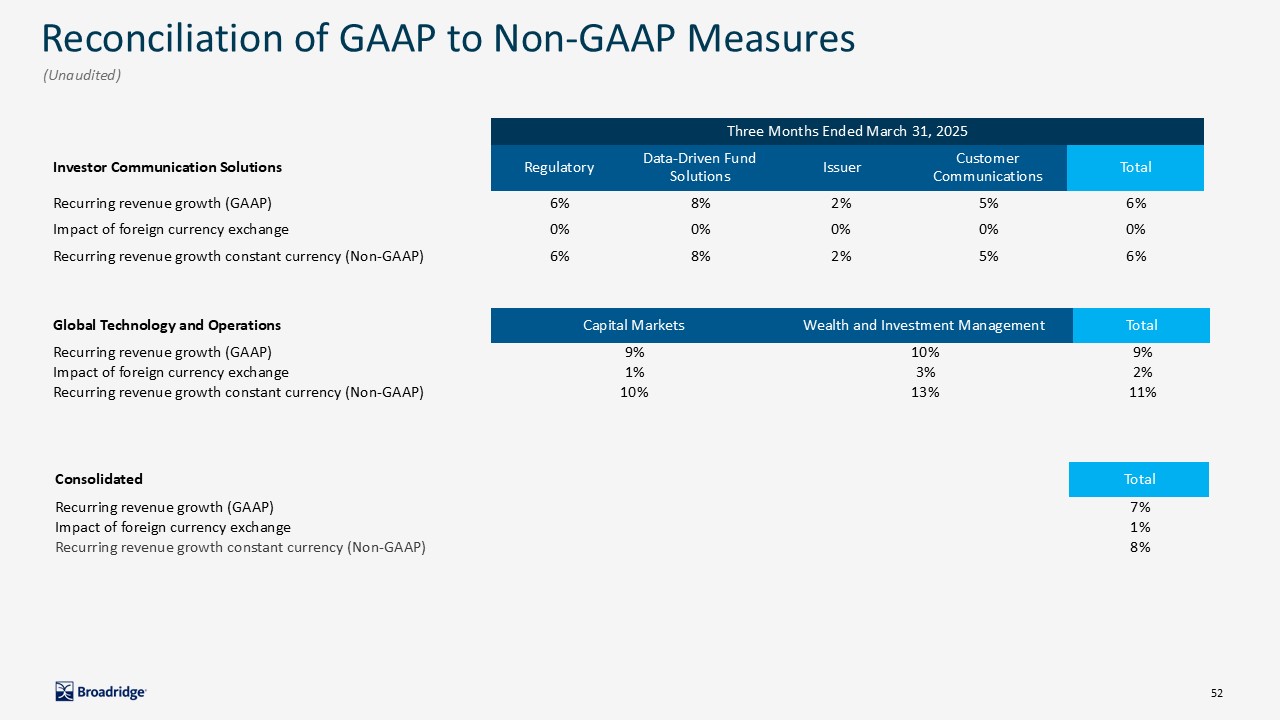
Reconciliation of GAAP to Non-GAAP Measures (Unaudited) Three Months Ended March
31, 2025 Investor Communication Solutions Regulatory Data-Driven Fund Solutions Issuer Customer Communications Total Recurring revenue growth (GAAP) 6% 8% 2% 5% 6% Impact of foreign currency exchange 0% 0% 0% 0% 0% Recurring
revenue growth constant currency (Non-GAAP) 6% 8% 2% 5% 6% Global Technology and Operations Capital Markets Wealth and Investment Management Total Recurring revenue growth (GAAP) 9% 10% 9% Impact of foreign currency
exchange 1% 3% 2% Recurring revenue growth constant currency (Non-GAAP) 10% 13% 11% Consolidated Total Recurring revenue growth (GAAP) 7% Impact of foreign currency exchange 1% Recurring revenue growth constant currency
(Non-GAAP) 8%
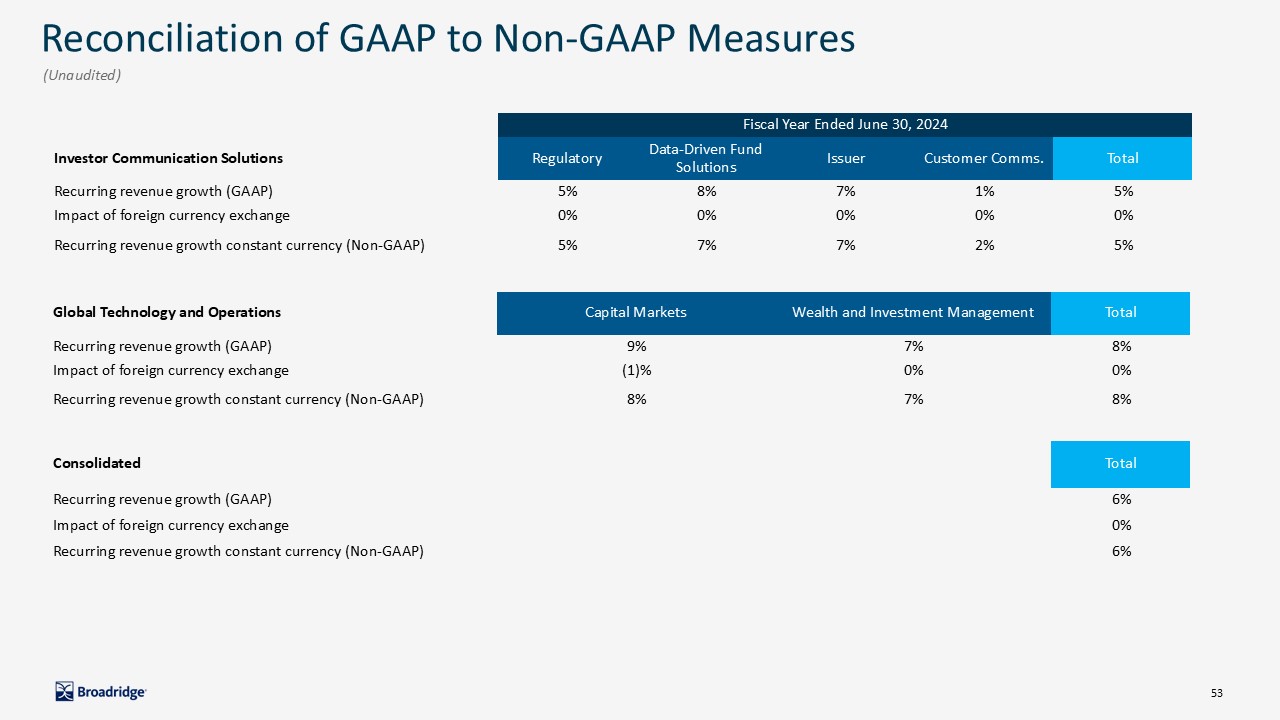
Reconciliation of GAAP to Non-GAAP Measures (Unaudited) Fiscal Year Ended June
30, 2024 Investor Communication Solutions Regulatory Data-Driven Fund Solutions Issuer Customer Comms. Total Recurring revenue growth (GAAP) 5% 8% 7% 1% 5% Impact of foreign currency exchange 0% 0% 0% 0% 0% Recurring revenue
growth constant currency (Non-GAAP) 5% 7% 7% 2% 5% Global Technology and Operations Capital Markets Wealth and Investment Management Total Recurring revenue growth (GAAP) 9% 7% 8% Impact of foreign currency
exchange (1)% 0% 0% Recurring revenue growth constant currency (Non-GAAP) 8% 7% 8% Consolidated Total Recurring revenue growth (GAAP) 6% Impact of foreign currency exchange 0% Recurring revenue growth constant currency
(Non-GAAP) 6%

Reconciliation of GAAP to Non-GAAP Measures (Unaudited) Fiscal Year Ended June
30, 2023 Investor Communication Solutions Regulatory Data-Driven Fund Solutions Issuer Customer Comms. Total Recurring revenue growth (GAAP) 6% 11% 12% 9% 8% Impact of foreign currency exchange 0% 1% 0% 0% 0% Recurring
revenue growth constant currency (Non-GAAP) 7% 12% 13% 10% 9% Global Technology and Operations Capital Markets Wealth and Investment Management Total Recurring revenue growth (GAAP) 7% 2% 5% Impact of foreign currency
exchange 4% 2% 3% Recurring revenue growth constant currency (Non-GAAP) 11% 4% 8% Consolidated Total Recurring revenue growth (GAAP) 7% Impact of foreign currency exchange 1% Recurring revenue growth constant currency
(Non-GAAP) 9%
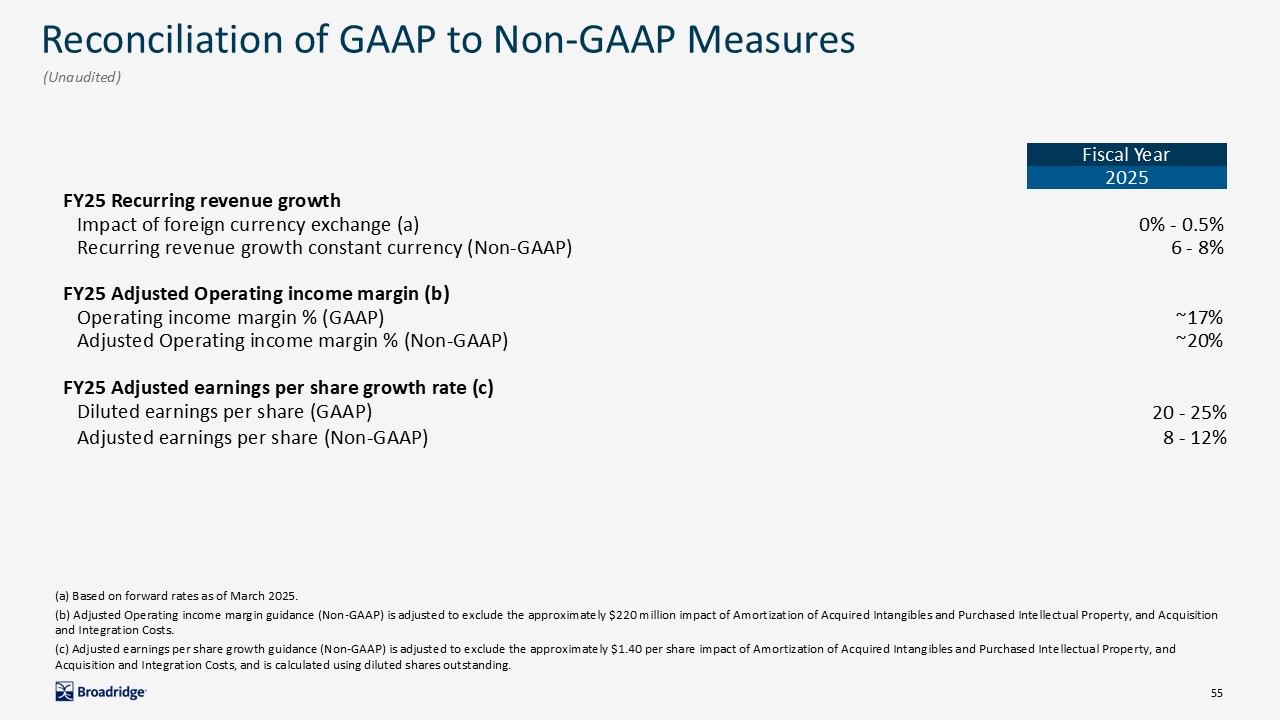
Reconciliation of GAAP to Non-GAAP Measures (Unaudited) Fiscal Year 2025 FY25
Recurring revenue growth Impact of foreign currency exchange (a) 0% - 0.5% Recurring revenue growth constant currency (Non-GAAP) 6 - 8% FY25 Adjusted Operating income margin (b) Operating income margin % (GAAP) ~17% Adjusted
Operating income margin % (Non-GAAP) ~20% FY25 Adjusted earnings per share growth rate (c) Diluted earnings per share (GAAP) 20 - 25% Adjusted earnings per share (Non-GAAP) 8 - 12% (a) Based on forward rates as of March 2025. (b)
Adjusted Operating income margin guidance (Non-GAAP) is adjusted to exclude the approximately $220 million impact of Amortization of Acquired Intangibles and Purchased Intellectual Property, and Acquisition and Integration Costs. (c) Adjusted
earnings per share growth guidance (Non-GAAP) is adjusted to exclude the approximately $1.40 per share impact of Amortization of Acquired Intangibles and Purchased Intellectual Property, and Acquisition and Integration Costs, and is calculated
using diluted shares outstanding.

Contact Investor Relations broadridgeir@broadridge.com